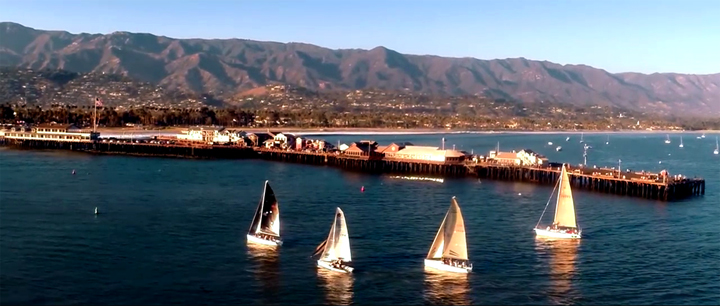
|
Click on the image for a larger picture. A view northeast across the Pacific Ocean off the coast of Santa Barbara, California, to Stearns Wharf and Santa Barbara's Montecito district (hills near center), with the Santa Ynez Mountains along skyline. Photograph courtesy Eric Foote, 2014; I edited and processed the image through photoshop. Santa Barbara, California, is the place to visit to investigate the appropriately named middle Pleistocene Santa Barbara Formation, which yields nearly 300 species of Ice Age mollusks (gastropods, pectens, oysters, clams, cockles, chitons, scaphopods, and mussels); brachiopods; bryozoans; corals; ostracods (a diminutive bivalve crustacean); algae; and worm tubes--plus, over a hundred species of foraminifera. |
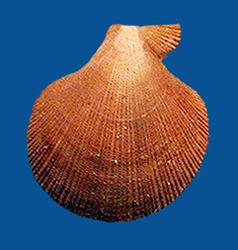 |
 |
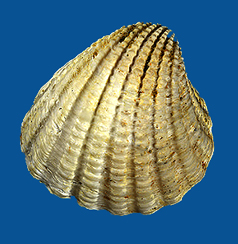 |
|
Three representative fossil specimens from the marine middle Pleistocene Santa Barbara Formation, Santa Barbara, California. At left is an extinct pelecypod (bivalve) pecten called, Chlamys opuntia; it's 5.0 cm in length--two inches long. I collected it from exposures along a county road in Santa Barbara, California. I originally photographed the scallop shell with a Minolta 35mm camera. Middle fossil is a gastropod mollusk called Crossata californica; 66.7 mm in length--2.63 inches long. Photograph courtesy Mr. Phil Liff-Grieff, who collected the specimen from world-famous Ice Age Fossil Hill in Santa Barbara County, California; I edited and processed the image through photoshop. At right is an extinct pelecypod clam referred to Cyclocardia californica, from a locality in Santa Barbara, California. It's 2.0 cm in width--0.78 inch wide. Photograph courtesy the Natural History Museum of Los Angeles County--from a publicly accessible site; I edited and processed the image through photoshop. |
|
Santa Barbara is an internationally renowned attraction located along the coast of Southern California approximately 100 miles north of Los Angeles. For decades the community has served as an ideal environment for assorted celebrities and other folks looking for a pleasurable get-away. Its climate has been liberally praised by those who ought to know, the jet-setters, as one of the very best in the world, and its jewel-like setting along a fertile plain between a breathtaking expanse of the Pacific Ocean and a rugged backdrop of the chaparral-coated Santa Ynez Mountains contributes to the impressive scenic reputation of the area. Santa Barbara obviously has no need of "hype." It is a rare and special paradise. But, what makes it even more attractive to many is the abundance of well-preserved fossils that can be found throughout the region. For example, among its many undeniable paleontological charms, the Santa Barbara area is especially rich in Ice Age fossils. The appropriately named middle Pleistocene Santa Barbara Formation (first described and then named in the technical scientific literature for its most typical exposures in Santa Barbara) just happens to yield one of the largest and best preserved marine Pleistocene invertebrate faunas on the US West Coast. It's a really huge fauna, indeed, with approximately 400 taxa thus far identified: 91 bivalve molluscan forms (AKA, the pelecypods--or, the Lamillebranchia of older taxonomical terminology) such as pectens, clams, cockles, oysters, and mussels; 173 gastropods (the snails); 6 chitons; 3 scaphopods; pteropods; brachiopods; bryozoans; corals; ostracods (minute bivalve crustaceans); worm tubes; and around 102 species of foraminifers (minute shells with geometrically intricate internal structures, secreted by a single-celled organism--usually considered microfossils). Current geochronological considerations place the Santa Barbara Formation at approximately 1.2 million to 400,000 years old--although most of the world-class fossil occurrences lie between 1,000,000 to 750,000 years old (middle Pleistocene in geologic age). Within the city limits of Santa Barbara, surface exposures of the Santa Barbara Formation rarely exceed 500 feet thick; yet, subsurface analyses demonstrate that, cumulatively, sedimentary deposition amassed an aggregate of well over 2,000 feet of marine-originated sands, silts, muds, and marls that, above-ground, contain locally abundant and often extraordinarily well-preserved invertebrate animals whose modern-day representatives, as a general rule, reside in marine environments significantly cooler than those off the coast of southern California today. The most classically fossiliferous outcrops of the middle Pleistocene Santa Barbara Formation can be observed at a number of sensational sites--namely: (1) The type locality, positioned amidst the community of Santa Barbara--where of course geologists first named and described the Santa Barbara Formation in a peer-reviewed scientific document (yields beaucoup pectens, clams, gastropods, and bryozoans); (2) "Foram Avenue" (a colloquial name)--a roadcut along a residential street in Santa Barbara, where paleontologists have not only identified some 102 species of foraminifera, but also loads of quality, identifiable pelecypods and gastropods; (3) The County Road--an informal title given to a specific street in Santa Barbara that yields astounding quantities of bryozoan "twigs," pecten shells, gastropods, and brachiopods; and (4)--The paleontological crown jewel of the Santa Barbara Formation, a place often referred to as Ice Age Fossil Hill, in the vicinity of Santa Barbara, within Santa Barbara County--a world-famous site that in addition to yielding 59 species of pelecypodal bivalves and 120 kinds of gastropods from some 25 separate fossiliferous beds, also produces numerous bryozoans, corals, brachiopods, worm tubes, ostracods (a diminutive bivalve crustacean), foraminifers, and algal developments from a roughly 300 foot-thick section of muddy to silty sedimentary detrital constituents deposited primarily in a shallow subtidal paleo-marine environment some one million years ago during the middle Pleistocene epoch; the vast majority of extant mollusks recovered from Ice Age Fossil Hill lived in waters from 20 to 40 m (65 to 98 feet) deep. A number of years ago, while I lived in Santa Barbara, California, I happened to independently discover the spectacular fossil locality that not a few folks now call Ice Age Fossil Hill. As a matter of fact, that was such a powerfully exhilarating and rewarding paleontological experience that happily, to commemorate the event, I actually wrote a contemporaneous account of it in one of my field notebooks that I fortuitously rediscovered not too long ago (I thought I'd long-lost it, interestingly enough). I've transcribed that entry herein, in quotes: "January 30: This afternoon, I discovered the best Pleistocene fossil locality I have ever seen, and quite possibly the best fossil locality period--in terms, that is, of abundance, variety and preservation of specimens; for here, sketching along the road and opposite side of the hill, occur several mollusk horizons in weakly consolidated brown to yellow-gray sand and silt. Successive strata contain a wide variety of specimens well preserved, and in an hour and a half's time I collected no less than 15 different species without the aid of paleontology equipment. I merely plucked fossils from the soft sandy Pleistocene formation (it's either the Ventura Sand or Santa Barbara formation, lower Pleistocene in geologic age). The lowermost fossiliferous stratum that I saw contained abundant pecten specimens; (thin-shelled Pecten bellus?) that might mark the Pleistocene-Pliocene boundary. This entire assemblage is similar in variety to the famed Palos Verdes Sand and the related formation, the San Pedro Sand, because I've found in all three such excellently preserved fossils as Conus californicus, Olivia, Pecten, etc.--typical Pleistocene forms that inhabited an ocean slightly colder than our present Pacific. "I'd like to return well-prepared for paleontology: to have with me a back pack, rock hammer (geology pick), plastic bags, tissue paper (for wrapping delicate specimens), notebook, pencil, and my formal biology kit which contains sharp dissecting needles (good for probing in soft sand, for picking dirt away from easily fractured forms), and probes (these possess sturdier needles that remove compacted sands and silt better than the dissecting variety). When next I visit the unbelievable exposure, I'll bring these valuable tools and conduct more scientific explorations. Armed with beneficial paleontological tools, I should be able to free some of the more fragile specimens embedded in hard sand. "I can't help but compare this locality with one of the most famous fossil localities in the United States--a street-level exposure of Palos Verdes Sand in San Pedro, where thousands of perfectly preserved mollusks erode from a narrow strip of ancient ocean sand. The fossiliferous seam is covered by a thin veneer of younger reddish alluvium, in which the bones of Pleistocene mammals and birds have occasionally been found. At my new locality, there is not one rich horizon, but several outstanding ones and their specimens are just as unusually well preserved. It's almost as if you were holding a shell that only yesterday had been buried on the beach. "One could spend much time there collecting specimens from the ascending fossil strata--making a scientific study of them, determining the ages of each horizon and the fauna they contain. It would make a fine project, I think. And the hill's thickness is easily determined--its dip and strike of strata, also. They dip generally northward, though for true accuracy I'd need a Brunton compass, a remarkable geological tool. "I don't know exactly why I decided to stop off there. For a long while I had wanted to examine some of the sedimentary formations exposed along that route, but had never put my desires into action--until today. Sort of on the spur-of-the-moment I left my main route and discovered the abundance of Pleistocene fossils weathering free. To collect them was easy and fun and I could at this moment --12:20 am--return." And so began my long-term paleontological infatuation with Ice Age Fossil Hill. Throughout my stay in Santa Barbara, I occasionally visited the locality and eventually amassed quite a representative selection of molluscan, byrozoan, coraline, foraminiferal, and even brachiopodal material from the middle Pleistocene Santa Barbara Formation. In addition to the justifiably famous Ice Age fossil occurrences in the Santa Barbara Formation, a number of other Pleistocene geologic deposits in the vicinity of Santa Barbara also yield diagnostic fossil assemblages. One accessible and notably fossiliferous section can be examined at an emergent marine terrace, roughly 47,000 years old (late Pleistocene in geologic age), which yields an open-coast invertebrate fauna consisting of approximately 125 taxa, including 102 mollusks (bivalve pelecypods and gastropods), 18 foraminifers, and a solitary coral--Balanophyllia elegans. Several such fossiliferous Pleistocene emergent marine terraces can be examined along the coast of Southern California (the Palos Verdes-San Pedro district of Los Angeles for one, of course, yields a world-class assemblage of late Pleistocene invertebrate paleontology). They're created when, first-off, an interglacial period of world-wide atmospheric cooling locks up great quantities of oceanic water as polar ice. That causes the sea level to drop along the coast, exposing land and whatever invertebrate animal life happened to live in the intertidal zone. After that, if the environmental conditions are just right, detritus carried by rivers and streams and alluvial processes eventually buries the area now left high and dry, preserving in often exquisite detail the many evidences of marine Pleistocene animal life within. Once the interglacial period is over--the Santa Barbara marine terrace, by the way, was created during what stratigraphers call the Wisconsinan Glaciation Episode about 47,000 years ago--when polar ice melts and sea levels concomitantly begin to rise, you then need geophysical tectonic activity to gradually elevate the block/ledge of marine invertebrates now submerged beneath the very sea waters in which they originally lived. When the old sea bed finally reemerges from the ocean, a marine terrace is born and is once again subjected to erosion and, possibly, additional processes of terrestrial sedimentary deposition. A second site of exceptional Ice Age paleontology occurs on Santa Rosa Island, Channel Islands National Park, off the coast of Santa Barbara, where the remains of a dwarf mammoth occur in late Pleistocene terrestrial detritus (recommendation: when in Santa Barbara, visit the Santa Barbara Museum of Natural History, where several skeletal elements from "Rosy" the dwarf mammoth are on display). A number of the Channel Islands also reveal evidence of Pleistocene marine terraces, loaded with abundant significant Ice Age invertebrate remains. A third Ice Age spot of note lies several miles south of Santa Barbara, proper, in the vicinity of Carpentaria, Santa Barbara County--the renowned Carpenteria Tar Pits, which yielded a faunal assemblage similar to the La Brea Tar Pits in Los Angeles; mostly, the Carpenteria brea deposit produced a paucity of rather poorly preserved mammals (a horse and a camel, for example) and some 79 species of birds, including a bald eagle, golden eagle, cooper hawk, sharp-shinned hawk, barn owl, California condor, Merrium’s Teratorn, pelicans, rails, ducks, king birds, western meadow larks, crows, scrub jays, finches, turkeys, road runners, wood peckers, and band-tailed pigeons. Plant remains recovered belong to Monterey pine (cones), Cypress (cones), oak, manzanita, juniper, and fir--all of which suggest that Ice Age Carpenteria probably resembled today's Monterey Peninsula, much farther north along California's coast. The primary scientific conservational problem with the Carperteria Tar Pits is that for decades they were used as a refuse dump--a long-term land status that obliterated the paleontological integrity of the original late Pleistocene deposit. Not only is Santa Barbara famous for its Ice Age fossil remains, but geologically older Cenozoic Era rock deposits within the general vicinity of the community also contain locally common to abundant paleontolocal preservations. A good place to start would be the south-facing front of the Santa Ynez Mountains, which form the dramatic backdrop to Santa Barbara immediately north of town (one must note that this is indeed California's "South Coast" area, where with peculiar improbability one must actually travel south--not the assumed traditional direction west--in order to reach the Pacific Ocean). It's comprised primarily of four quite famous marine Eocene-age geologic rock formations that in ascending order of geologic age (oldest to youngest) include: the Juncal Formation; the Matilija Sandstone; the Cozy Dell Shale; and the Coldwater Sandstone, which in turn is overlain by a younger entirely terrestrial geologic rock accumulation called the upper Eocene to Oligocene Sespe Formation. Although unfossiliferous throughout the Santa Barbara region (save for reworked fragments of oysters derived from the older underlying middle Eocene Coldwater Sandstone), the Sespe Formation exposed in Ventura County, several miles southwest of Ventura (which lies some 35 to 40 miles south of Santa Barbara), yielded one of the largest assemblages of late Eocene to Oligocene mammals west of the Rocky Mountains. The majority of vertebrate remains came from three separate sites: in the general neighborhood of a modern landfill operation; and the noted Pearson Ranch and Kew quarries, both situated on private property in the Las Posas Hills northwest of Thousand Oaks. Vertebrate paleontologists Chester Stock and R.W. Wilson conducted most of the scientific collecting from the Pearson Ranch and Kew quarries during the 1930s and '40s. Among their numerous important finds were large cats, early saber-toothed cats, dogs, a squirrel-like rodent, a squirrel, field mice, rabbits, a small "deerlet," primitive opossums, early insectivores, primitive rodents, an early rhinoceros, a brontothere, a rhinoceros-like animal, a primitive hedgehog, and an early lemur monkey. Among the marine Eocene units exposed in Santa Barbara's Santa Ynez Range district, the middle Eocene Coldwater Sandstone is probably the best of the bunch for satisfying paleontological explorations; of course, all four formations yield fossil remains in varying degrees of abundance and excellence of preservation. In the Ojai district of neighboring Ventura County, for instance, the Cozy Dell Shale produces spectacular Brittle stars, while the Matilija Sandstone provides paleomalacologists with a large and varied Eocene molluscan fauna. Through the high resolution methodology of magnetostratigraphy (a reliable technique that allows precise geologic correlations based on the timing of past magnetic reversals in the Earth's poles), the Coldwater Sandstone has been dated with great accuracy at 42.5 to 39.5 million years old. Its upper 1,000 feet of stratigraphic exposure, particularly near the geologic contact with the upper Eocene to Oligocene Sespe Formation, produces prodigious numbers of Ostrea idriaensis and Ostrea tayloriana oysters, plus locally common pelecypodal clams and turritella-type gastropods. While I lived in Santa Barbara several years ago, one of my favorite Coldwater Sandstone fossil haunts was what many local paleontology enthusiasts called the "Coldwater Clam Quarry;" that's where numerous carbonized valves of pelecypods, common turritella gastropods, and even a shark tooth or two could be collected. Petrologically speaking, sands in the Coldwater Sandstone were deposited into a shallow gradually regressing middle Eocene sea by westward-flowing rivers that drained a granitic terrain--probably the ancestral Sierra Nevada. Too, a rather fascinating geological aside here is that as an integral lithologic member of the Santa Ynez Mountains (which belong to what geographers call the Transverse Ranges of Southern California), the Coldwater Sandstone went along for quite a wild geophysical ride. From roughly mid Miocene to early-late Miocene times--15.2 million to around 10 million years ago--tectonic forces rather rapidly (in a geological sense) rotated the original declination of the ancestral Santa Ynez Range some 56 degrees clockwise; after that, more gradual clockwise rotational movements, until about two million years ago, helped establish the present-day east-west geographic orientation of the Santa Ynez Mountains. After exploring the middle Eocene Coldwater Sandstone in the southern foothills of the Santa Ynez Mountains, fossil seekers might also want to investigate a representative sampling of Santa Barbara's many late Oligocene-Miocene-and Pliocene paleo-treasures. Oldest to youngest, some of the more notable examples include: the upper Oligocene to lower Miocene Vaqueros Formation (produces huge pectens, oysters, and turritella-style gastropods that flourished in warm tropical waters; furnishes many species of shark teeth, too); the middle Miocene Temblor Formation (the same geologic rock unit that preserves the fabulous Sharktooth Hill Bone Bed northeast of Bakersfield, California; in the Santa Barbara region, the Temblor contains large tropical-type gastropods and pelecypods, locally abundant sand dollars, brachiopods, and occasional marine mammal skeletal elements ); the middle to late Miocene Monterey Formation (yields an astounding variety of fossil remains: a plethora of microfossils--foraminifers, diatoms, and radiolaria--seaweeds; whales; sea lions; walruses, bony and cartilaginous fishes; and birds); the middle Miocene Branch Canyon Formation (its so-called "echinoid optimum" zone provides plentiful sand dollars from a pure sandstone paleo-beach interval stratigraphers correlate with diatomaceous shales of the coastal Monterey Formation); the upper Miocene to lower Pliocene Sisquoc Formation (it's an especially rich paleontological zone, preserving the remains of diatoms, radiolarians, arenaceous foraminifers, sponges, and occasional marine mammal bones); the upper Miocene to lower Pliocene Santa Margarita Formation (yields prodigious quantities of barnacles, sizable pectens, clams, echinoids, and a monstrous oyster called appropriately enough, Ostrea titan); and the upper Pliocene Careaga Formation (produces myriads of fantastically well preserved mollusks--bivalve pelecypodal examples, and gastropods--in addition to locally prodigious quantities of exceptional echinoids (sand dollars). That would constitute but a sampling of paleontological opportunities one could seriously consider exploring in Santa Barbara County. Please note, of course, that all the usual collecting admonitions apply here: Among them--You need explicit written permission from land owners to fossil prospect on private property; you must contact the local United States Forest Service folks to learn their latest official directives regarding unauthorized fossil collecting in the Los Padres National Forest; and, finally, before hiking along trails in the Los Padres National Forest above Santa Barbara, you just might need to purchase an Adventure Pass--it's a wholly local pass often required when exploring by non-mechanized means the Angeles, Cleveland, Los Padres, and San Bernardino National Forests of Southern California. With collecting bona fides properly established through due diligence, one naturally begins to wonder whether specific seasonal meteorological conditions impinge on paleontological exploration activities. The abbreviated answer is: not a chance. Temperatures remain consistently moderate year-round. And while the region does indeed experience a definite winter-early spring rainy season, fossil hunting in Santa Barbara can be comfortably conducted any time of the year. The community officially averages some 19.41 inches of precipitation per year, and the highest elevations in the neighboring Santa Ynez Mountains (3,800 to 3,900 feet) receive approximately 35 inches of rain annually--including on occasion a dusting of snow. Of course, when the fossil hunting is finished for the time being--it's certainly time to participate in different forms of entertainment. Because, obviously, there is much more to experience in Santa Barbara than paleontological investigations, alone. It's a community famously geared toward tourism. A few of the more-popular attractions include: the Botanical Gardens; the Mission (generally considered by a majority of architectural historians as the most aesthetically striking of all the old missions in California); the Museum of Natural History (which boasts an excellent geology section with an educational display of gems and minerals and local fossils); the Santa Barbara courthouse--from whose tower is obtained an outrageously inspiring 360 degree panorama of the city, Santa Ynez Mountains, and Pacific Ocean; and, naturally, the clean gorgeous beaches. There are innumerable eateries, from the inevitable fast food establishments to world-class restaurants--in addition to any number of hotel and motel accommodations. While all of Santa Barbara's Ice Age fossil localities could theoretically be visited in reconnaissance style in a single afternoon, you'll likely want to spend a few extra days in Santa Barbara to check out the sights. Camping places along the beach--all within 20 to 30 miles of Santa Barbara--include Gaviota, Refugio Beach, El Capitan Beach, and Carpenteria Beach. For camping in the Santa Ynez Mountains, try the Santa Ynez River tract area a few miles south of Lake Cachuma, east of State Route 154, along Paradise Road about 15 miles northwest of Santa Barbara. Here can be found several quality campgrounds, including Fremont, Los Prietos, Lower Oso, Santa Ynez and Redrock. My favorite time of year in Santa Barbara is fall, when the days are sunny, warm and clear--no dismal chilly fog to speak of--and the nights dazzling with stars, with a moderate crisp coolness to the air. The sunsets over the Pacific are extraordinary in autumn, and while I resided in Santa Barbara a number of years ago I'd sometimes hike to the Coldwater Clam Quarry in late afternoons, timing my fossil hunting to coincide with the glowing spectacle out over the ocean; then when it was too late to find fossils, I'd sit along the edge of the trail, reverent in the presence of the glorious colors of the sinking sun. In the afterglow of twilight I'd head back down the mountain slope clutching the remains of clams that some 40 million years ago lived in a different ocean--a sea now long-vanished but one which also felt the setting of that same sun. |

| Click on the image for a larger picture. A Google Earth street car perspective that I edited and processed through photoshop. The view is southeast across the northwest-facing side of world-famous Ice Age Fossil Hill, in the vicinity of Santa Barbara, California, to exposures of the abundantly fossiliferous middle Pleistocene Santa Barbara Formation (here, about 1,000,000 years old)--slopes at upper center to upper left; rocks at lower left to roughly center, nearest the asphalt, also belong to the middle Pleistocene Santa Barbara Formation. Pacific Ocean in distance. Here's where paleomalacology enthusiasts can explore some 25 individual beds that yield nearly 200 species of mollusks (gastropods, pectens, clams, oysters, mussels, chitons, scaphopods, and cockles)--in addition to brachiopods, bryozoans, corals, ostracods, foraminifers, algae, and worm tubes. |

| Click on the image for a larger picture. A viewing perspective slightly west of due north (Santa Ynez Mountains along skyline). This is a year 2002 field trip to Ice Age Fossil Hill, in the vicinity of Santa Barbara, California, by the Pacific Conchological Club. They're collecting supremely well preserved invertebrate fossils from the middle Pleistocene Santa Barbara Formation--here, around 1,000,000 years old. Beaucoup gastropods, pelecypods (pectens, clams, oysters, mussels), bryozoans, brachiopods, corals, osctracods, worm tubes, algae, and foraminifers occur here in abundance. Photo courtesy Phil Liff-Grieff; I edited and processed it through photoshop. |
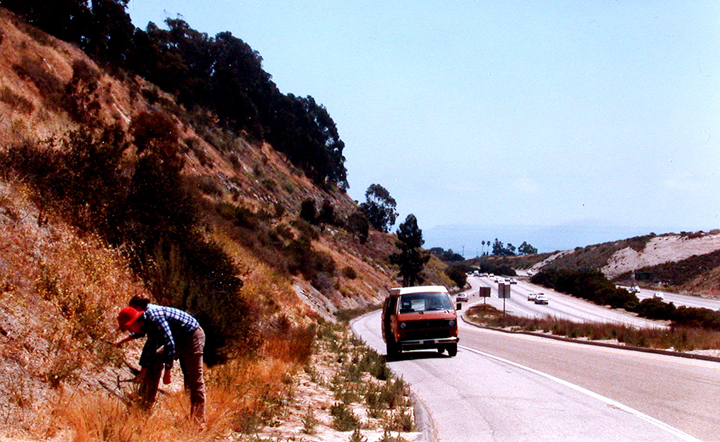
| Click on the image for a larger picture. A look somewhat east of due south to folks exploring exposures at Ice Age Fossil Hill, Santa Barbara County, California. They're searching for the outrageously abundant and well preserved gastropods, pelecypopds (pectens, clams, oysters, and mussels), brachiopods, bryozoans, corals, ostracods, foraminifers, worm tubes, and algae that occur within the fine sands and clays of the middle Pleistocene Santa Barbara Formation--here, approximately 1,000,000 years old. A year 1985 photograph, courtesy W.R.C. Shedenhelm; I edited and processed it through photoshop. |
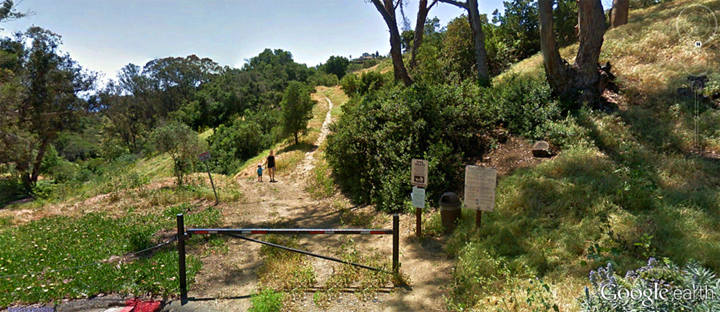
| Click on the image for a larger picture. A Google Earth street car perspective (snapped during April, 2016) that I edited and processed through photoshop. The viewing direction is due south. Here's a pastoral trail system that winds its way through vegetation growing atop the often highly fossiliferous middle Pleistocene Santa Barbara Formation; everything in view is on the Santa Barbara Formation. This is the closest one can approach by vehicle to the very spot where geologists first described the Santa Barbara Formation in the scientific literature (in 1931); that famous type locality lies approximately a quarter mile from the gate. |
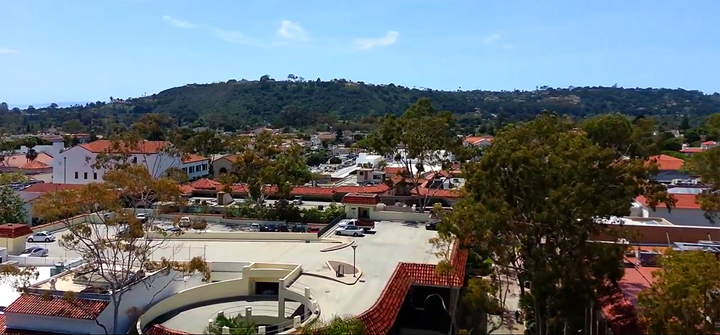
| Click on the image for a larger picture. The view is slightly west of due south, across downtown Santa Barbara, California, to the type locality for the middle Pleistocene Santa Barbara Formation, which yields nearly 300 species of Ice Age mollusks (gastropods, pectens, oysters, clams, cockles, chitons, scaphopods, and mussels); brachiopods; bryozoans; corals; algae; and worm tubes--plus, over a hundred species of foraminifera. The very spot where geologists first described the Santa Barbara Formation in the scientific literature (in 1931) lies along that ridge in distance. Photograph courtesy David Patten, 2014; I edited and processed the image through photoshop. |
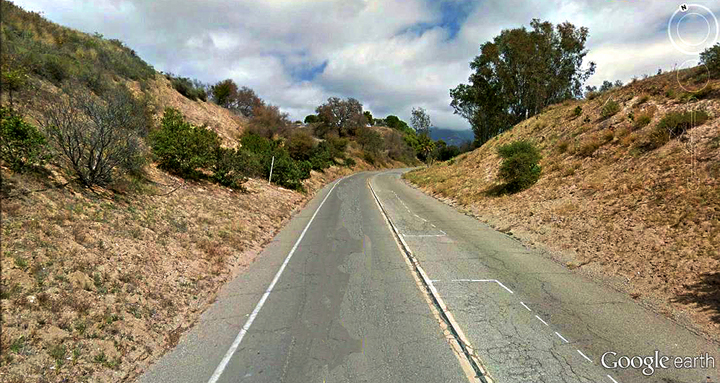
| Click on the image for a larger picture. A Google Earth street car perspective, snapped sometime in 2012, that I edited and processed through photoshop. The directional view is a tad east of due north along a county road in Santa Barbara, California--the so-called County Road locality. Both sides of the road yield prolific quantities of perfectly preserved pectens (scallop shells--a pelecypod) and bryozoans in the middle Pleistocene Santa Barbara Formation; gastropods and brachiopods also common here. |
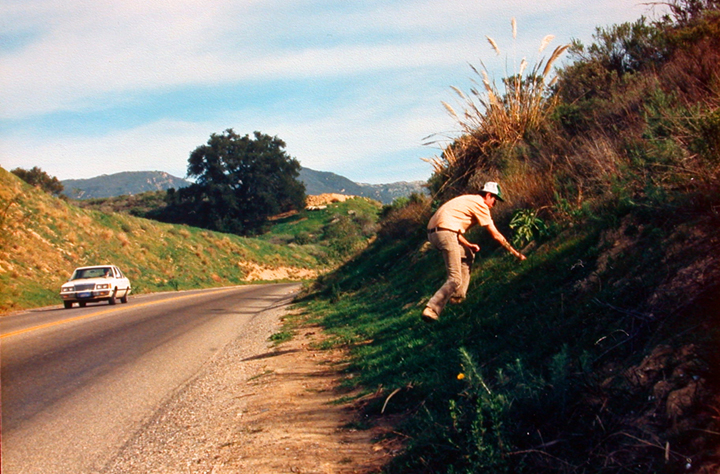
| Click on the image for a larger picture. The camera is pointed roughly due north along a county road in Santa Barbara, California--the so-called County Road locality. A photograph that rather comically captures an eager collector scrambling up a fossil-bearing roadcut in the middle Pleistocene Santa Barbara Formation, with a spectator in a passing car looking on. Both sides of the road yield prolific quantities of perfectly preserved Ice Age pectens (scallop shells--a pelecypod) and bryozoans in the Santa Barbara Formation; gastropods and brachiopods also common here. Santa Ynez Mountains along the skyline, in distance. Photograph originally snapped with a Minolta 35mm camera. |
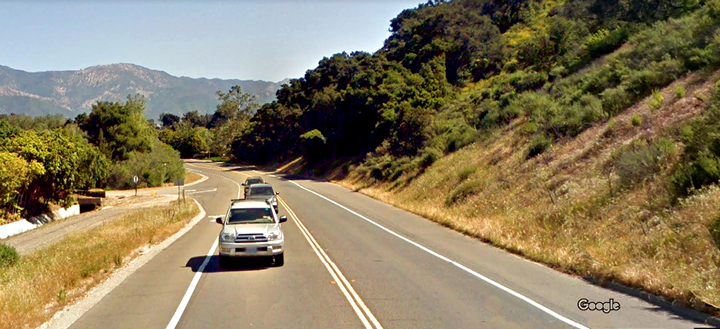
| Click on the image for a larger picture. A Google Maps street car perspective (snapped in April, 2017) that I edited and processed through photoshop. The Google camera is pointed northeast along a residential road in Santa Barbara, California. Hillside at right is but part a rather extensive natural exposure of the middle Pleistocene Santa Barbara Formation, which locally yields prolific quantities of perfectly preserved Ice Age gastropods, pectens, clams, oysters, mussels, bryozoans, brachiopods, corals, foraminifers, worm tubes, and algae. Santa Ynez Mountains in distance, five miles from this exposure of the Santa Barbara Formation. Elevation at street level is 88 feet; that peak along the skyline-is 3,800 feet high. |
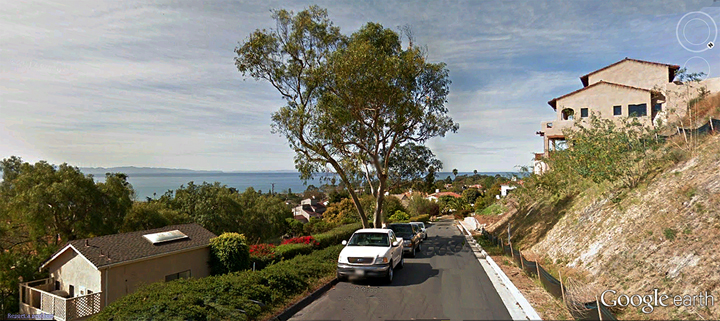
| Click on the image for a larger picture. A Google Earch street car perspective that I edited and processed through photoshop. The view is southwest. Here's what it's all about in Santa Barbara, California: Spectacular vistas and prolific Pleistocene paleontology. That roadcut at right, in a quiet residential district in Santa Barbara, exposes the often abundantly fossiliferous sands and silts of the marine middle Pleistocene Santa Barbara Formation--as a matter of fact, that home at upper right is sitting right on top of one of the world's more prolific producers of fossil marine mollusks--nearly 300 species have thus far been identified by invertebrate paleontologists from the Santa Barbara Formation. In the distance lies the Pacific Ocean, and the "mountains" along the horizon at mid-left actually belong to Channel Islands National Park--some 30 miles off shore. |
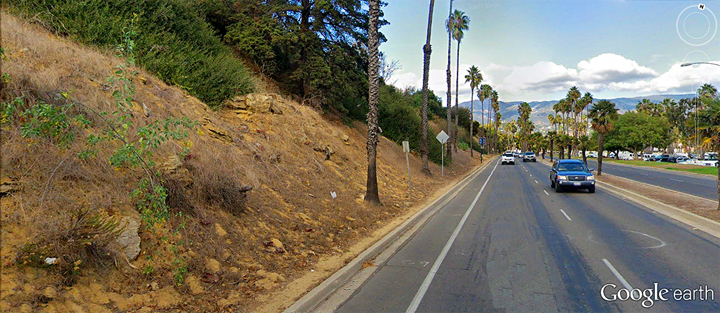
| Click on the image for a larger picture. A Google Earth street car perspective that I edited and processed through photoshop. The view is practically due north--with the Santa Ynez Mountains along skyline, in distance. The roadcut locality at left, stretching along a palm-line street in Santa Barbara, California, is often colloquially called Foram Avenue by micropaleontologists. It's a world-famous fossil locality in the middle Pleistocene Santa Barbara Formation, where the silts, sands, and marls yield some 102 species of exquisitely preserved benthic and planktonic foraminfera (minute shells with geometrically intricate living chambers secreted by a microscopic single-celled organism). The site also contains many species of gastropods, pelecypods, and bryozoans. As a matter of fact--this is the very place where I collected my very first fossil from the Santa Barbara Formation--a beautifully preserved clam called scientifically, Acila castrensis. |
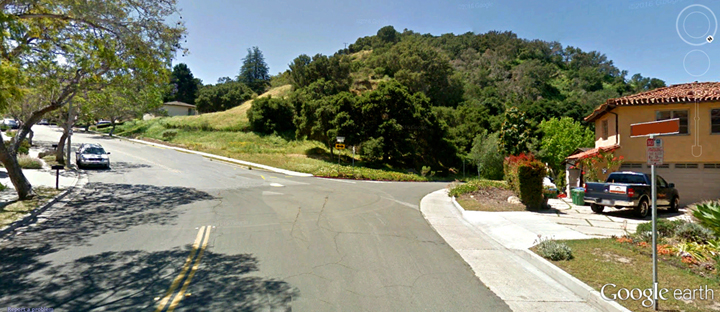
| Click on the image for a larger picture. A Google Earth street car perspective, snapped sometime in April, 2016, that I edited and processed through photoshop. The viewing direction is southwest, in a quiet residential neighborhood in Santa Barbara, California, to the northern and eastern sides of a hill developed in the often abundantly fossiliferous middle Pleistocene Santa Barbara Formation; this is but a little over a half mile from the type locality of the Santa Barbara Formation, where in 1931 U. S. Grant IV (grandson of US president U.S. Grant) and H. R. Gale first described the middle Pleistocene Santa Barbara Formation in the scientific literature (of course, it was originally mentioned informally as a geologic rock unit in a technical publication in 1912, and then later on once more in 1925). Less than a quarter mile from that hill in middle and upper right lies a famous and historic fossil locality registered with the Natural History Museum of Los Angeles County; both localities are of course now completely off limits to unauthorized collecting, lying as they do on private property. |
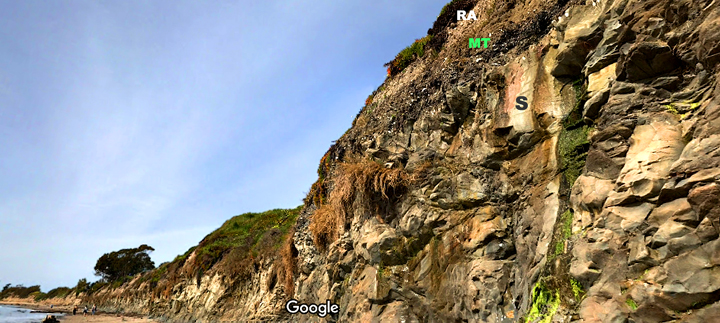
| Click on the image for a larger picture. A view along the coast of California, in the vicinity of Santa Barbara (patch of water along beach at lower left is the Pacific Ocean). Letters in photograph represent the following geologic units: Black letter S denotes the upper Miocene to lower Pliocene Sisquoc Formation (around 6 to 4 million years old); the Sisquoc is an especially rich paleontological unit, preserving the remains of diatoms, radiolarians, arenaceous foraminifers, sponges, and occasional sea mammal bones. Green letters MT represent the fossiliferous upper Pleistocene marine terrace deposits, roughly 47,000 years old; the unnamed Ice Age geologic rock unit produces over a hundred species of mollusks, in addition to 18 species of foraminifera. White letters RA at top of cliff stand for recent alluvium (eroded material younger than 11,000 years). A Google Maps photograph courtesy Mark Knight; I edited and processed the image through photoshop. |
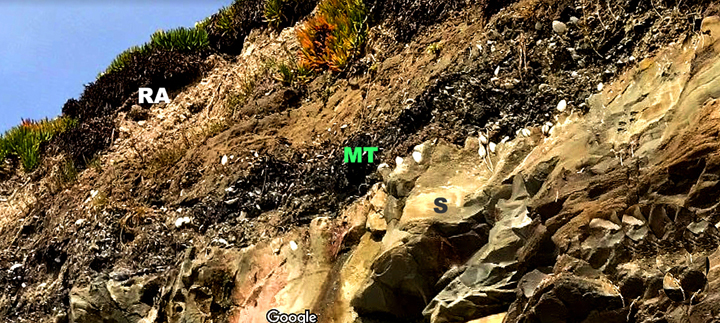
| Click on the image for a larger picture. A closer look at the fossiliferous layer in an unnamed upper Pleistocene marine terrace deposit--roughly 47,000 years old (seen in the previous image, above)--in the vicinity of Santa Barbara, California. Letters in photograph represent the following geologic units: Black letter S denotes the upper Miocene to lower Pliocene Sisquoc Formation (around 6 to 4 million years old); the Sisquoc is an especially rich paleontological unit, preserving the remains of diatoms, radiolarians, arenaceous foraminifers, sponges, and occasional sea mammal bones. Green letters MT represent the fossiliferous upper Pleistocene marine terrace deposits, roughly 47,000 years old; the unnamed Ice Age geologic rock unit produces over a hundred species of mollusks, in addition to 18 species of foraminifera. Whitish objects embedded in the silts and sands are actual fossil mollusks; note how a few of the pelecypods have burrowed down into the underlying late Miocene-early Pliocene Sisquoc Formation, which used to be the ocean floor upon which the Ice Age animals lived. White letters RA at top of cliff stand for recent alluvium (eroded material younger than 11,000 years). A crop of a Google Maps photograph courtesy Mark Knight; I edited and processed the image through photoshop. |

| Click on the image for a larger picture. At lower to mid left, that's the Pacific Ocean lapping up on a beach along the coast of Santa Barbara. That house with balcony at upper left is perched precariously on the sands, silts and muds of an emergent upper Pleistocene marine terrace deposit (roughly 47, 000 years old)--the pale brownish layer in approximately upper one-third of the cliff face; the unnamed geologic rock unit produces over a hundred species of mollusks, in addition to 18 species of foraminifera. Below the marine terrace material--the lower two-thirds down to beach level--is what's been mapped as the upper Miocene to lower Pliocene Sisquoc Formation (around 6 to 4 million years old); it's an especially rich paleontological unit, preserving the remains of diatoms, radiolarians, arenaceous foraminifers, sponges, and occasional sea mammal bones. A photograph courtesy Alex Snyder of the United States Geological Survey; snapped in February, 2017. I edited and processed the image through photoshop. |
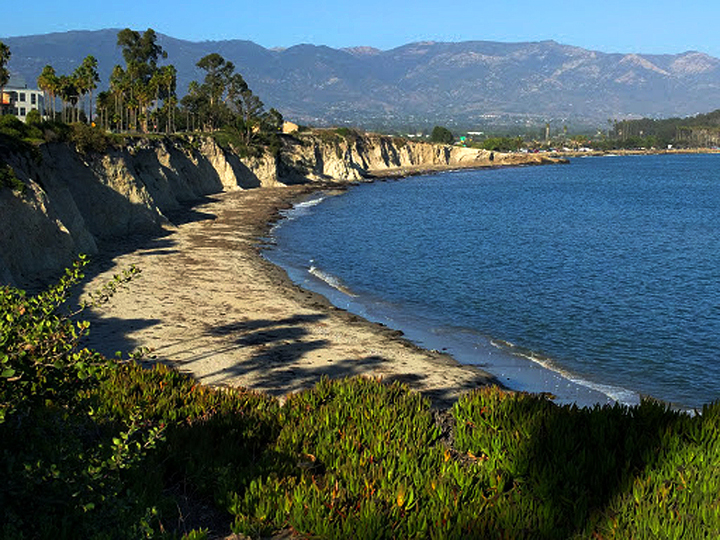
| Click on the image for a larger picture. A view roughly northeast along the coast of Santa Barbara, California. Sea bluffs facing the Pacific Ocean are composed of sands, silts and muds of an emergent upper Pleistocene marine terrace deposit (roughly 47, 000 years old); it's an unnamed geologic rock unit that produces over a hundred species of mollusks, in addition to 18 species of foraminifera. Santa Ynez Mountains in background. A photograph courtesy Sonya Wainwright, who uploaded it to Google Maps in September, 2017. I edited and processed the image through photoshop. |
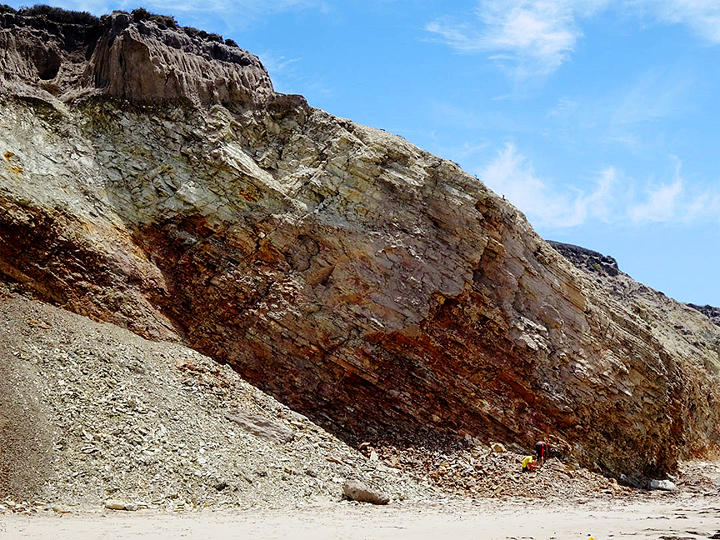
| Click on the image for a larger picture. A typical outcrop of fossiliferous siliceous shales in the middle to upper Miocene Monterey Formation (around 15 to 8 million years old), exposed along the Pacific Coast in the vicinity of Santa Barbara, California. The Monterey Formation here yields an extensive fish fauna, consisting of often excellently preserved complete skeletons. Photograph courtesy The Nautiloid Network. I eidted and processed the image through photoshop. |
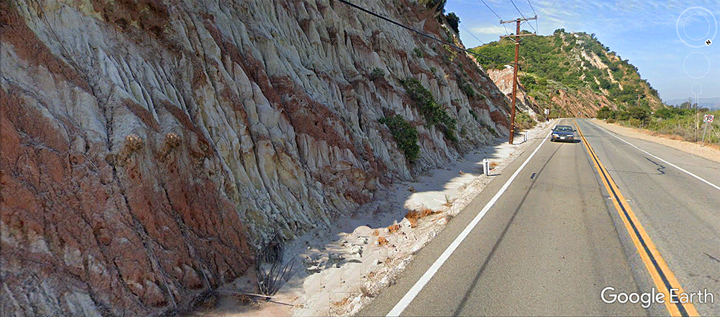
| Click on the image for a larger picture. A Google Earth street car perspective that I edited and processed through photoshop. The view is slightly northwest of due south along a road in Ventura County--a county that is contiguous with Santa Barbara County. That roadcut at left exposes Oligocene (about 28 million years old) bone-bearing sediments of the middle Eocene to lower Miocene (roughly 42 million to 20 million years ago) Sespe Formation, one of the most famous Cenozoic Era vertebrate fossil-bearing geologic rock units in all of southern California. Even though the Sespe sedimentary accumulation indeed represents a considerable interval of depositional history, spanning some 22 million years, the stratigraphic reality is that in most exposures practically all of the late Eocene through Early Oligocene time is completely missing, a period of roughly 12 million years when erosion removed much Sespe material, creating a dramatic disconformity in the geologic record. |
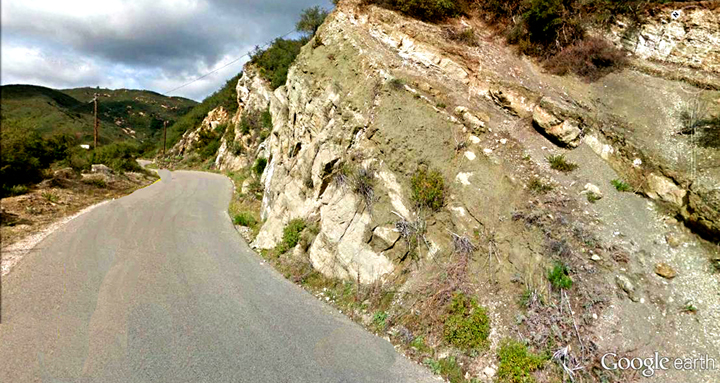
| Click on the image for a larger picture. A Google Earth street car perspective that I edited and processed through photoshop. The Google car camera is looking northeast along a county road in the foothills of the Santa Ynez Mountains, above (north of) the coastal community of Santa Barbara, California. Rocks exposed along the roadcut belong to the middle Eocene Coldwater Sandstone, which here produces numerous oysters and clams; technical magnetostratigraphic investigations (a high resolution methodology that allows precise geologic correlations based on comparisons with the timing of past magnetic reversals in the Earth's poles) demonstrate that the Coldwater Sandstone is roughly 42.5 to 39.5 million years old, which places it squarely in the late Uintan through mid Duchesnean Stages of the Eocene Epoch. Most of the Coldwater Sandstone oysters seen in the photograph in the Bonus Fossils From The Santa Barbara Area section, below, came from this specific locality. |
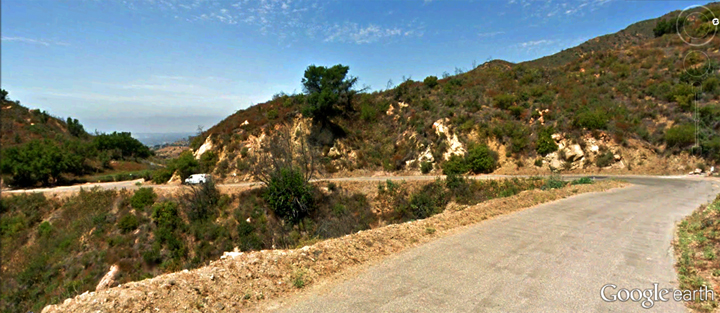
| Click on the image for a larger picture. A Google Earch street car perspective that I edited and processed through photoshop. The view is slightly north of due west along a county road in the foothills of the Santa Ynez Mountains, above (north of) the coastal community of Santa Barbara, California. Here is one of numerous hairpin turns one encounters when one negotiates by vehicle the slopes of the Santa Ynez Mountains; note the vehicle up ahead, for scale, at roughly mid-left. Rocks exposed along the roadcut, directly ahead, belong to the middle Eocene Coldwater Sandstone--here, quite fossiliferous with mollusks--a locality that happens to lie near the famous Coldwater Clam Quarry, where I collected the two carbonized clam shells seen below (in the Bonus Fossils From The Santa Barbara Area section). Technical magnetostratigraphic investigations (a high resolution methodology that allows precise geologic correlations based on comparisons with the timing of past magnetic reversals in the Earth's poles) demonstrate that the Coldwater Sandstone is roughly 42.5 to 39.5 million years old, which places it squarely in the late Uintan through mid Duchesnean Stages of the Eocene Epoch. |

| Click on the image for a larger picture. A look practically due north to a hiking path that leads toward a wilderness area near fossiliferous exposures of the middle Eocene Coldwater Sandstone, foothills of the Santa Ynez Mountains, just north of Santa Barbara, California. The Coldwater here yields several species of nicely carbonized bivalve pelecypods, in addition to occasional turritella gastropods and shark teeth. That Santa Ynez Mountains peak in background rises about 3,800 feet in elevation; it's carved in the Eocene Matilija Sandstone. Technical magnetostratigraphic dating (a high resolution methodology that allows precise geologic correlations based on comparisons with the timing of past magnetic reversals in the Earth's poles) demonstrates that the Coldwater Sandstone is roughly 42.5 to 39.5 million years old, which places it squarely in the late Uintan through mid Duchesnean Stages of the Eocene Epoch. A photograph I originally snapped with a Minolta 35mm camera; I took a picture of that photo with a Nikon CoolPix 995 digital camera, and then edited and processed the image through photoshop. |
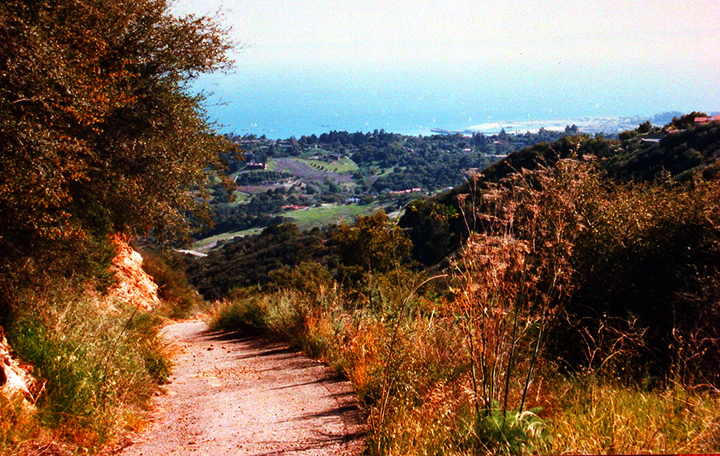
| Click on the image for a larger picture. An afternoon view practically due south at the Coldwater Clam Quarry in the middle Eocene Coldwater Sandstone, foothills of the Santa Ynez Mountains, just north of Santa Barbara, California--blue area in distance is the Pacific Ocean. The fossil-bearing sandstones can be seen at left, along the dirt path; that's the exact spot where I collected the two carbonized clam shells seen in the Bonus Fossils From The Santa Barbara Area section. The Coldwater Clam Quarry yields several species of nicely carbonized bivalve pelecypods, in addition to occasional turritella gastropods and shark teeth. Technical magnetostratigraphic dating (a high resolution methodology that allows precise geologic correlations based on comparisons with the timing of past magnetic reversals in the Earth's poles) demonstrates that the Coldwater Sandstone is roughly 42.5 to 39.5 million years old, which places it squarely in the late Uintan through mid Duchesnean Stages of the Eocene Epoch. A photograph I originally snapped with a Minolta 35mm camera; I took a picture of that photo with a Nikon CoolPix 995 digital camera, and then edited and processed the image through photoshop. |
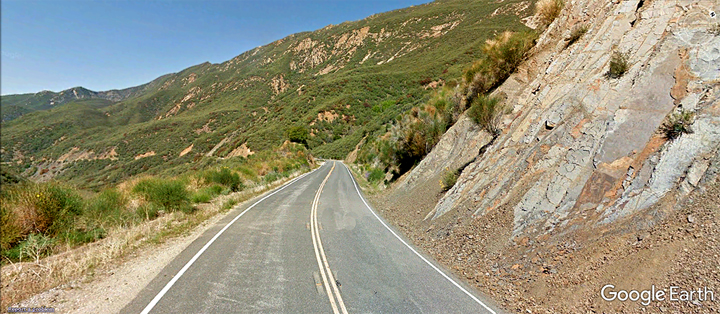
| Click on the image for a larger picture. A Google Earth Street car perspective that I edited and processed through photoshop. View is northeast in Ventura County--it is contiguous with neighboring Santa Barbara County--to a roadcut (right side of image) that exposes echinoderm-bearing clastic sediments of the middle Eocene Cozy Dell Shale. Beautifully preserved complete specimens of brittle stars occur at this specific locality. |
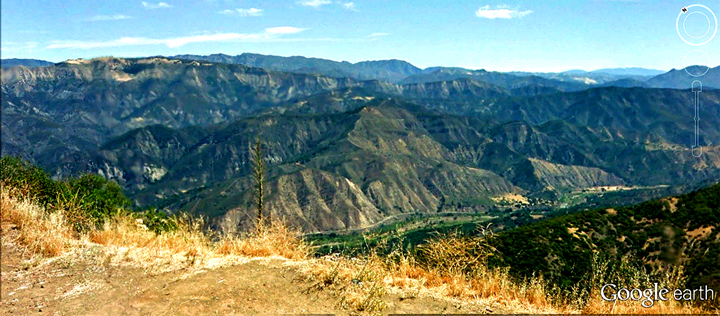
| Click on the image for a larger picture. Some of the great vistas in all of So Cal (AKA, Southern California) can be found in the Santa Ynez Mountains, which form the dramatic backdrop to Santa Barbara to the immediate north. A Google Earth street car perspective that I edited and processed through photoshop. Elevation here is 3,168 feet along the Camino Cielo, along the crest of the Santa Ynez Mountains directly north of Santa Barbara, California. The directional view is a little east of due north, situated 4.37 miles northwest of La Cumbre Peak--at an elevation of 3, 997 feet, the highest point in the Santa Ynez Mountains nearest Santa Barbara. Below is the Santa Ynez River valley (elevation 950 feet), and a wilderness region without permanent settlements stretches some 30 miles northward. |
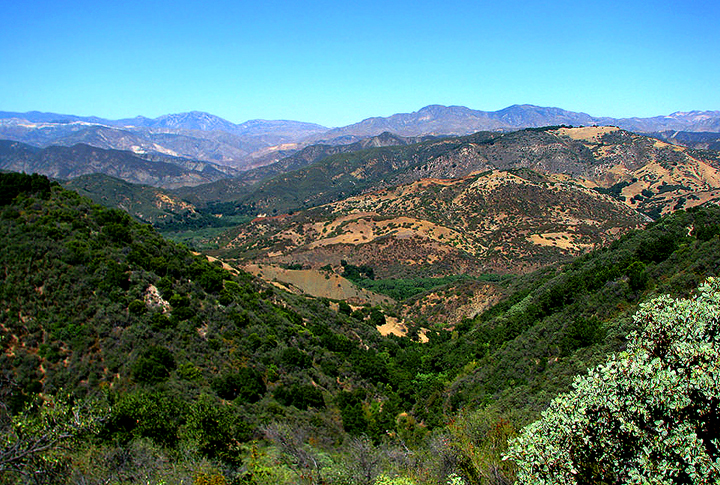
| Click on the image for a larger picture. Some of the great vistas in all of So Cal (AKA, Southern California) can be found in the Santa Ynez Mountains, which form the dramatic backdrop to Santa Barbara to the immediate north. The directional view is roughly due north along the Cold Springs Trail, northern side of the Santa Ynez Mountains, Santa Barbara County, California, to the vast chaparral vegetation wilderness that stretches without permanent settlements some 30 miles onward. Photograph courtesy James Wapotich--a picture snapped on January 1, 1980. I edited and processed the image through photoshop. |
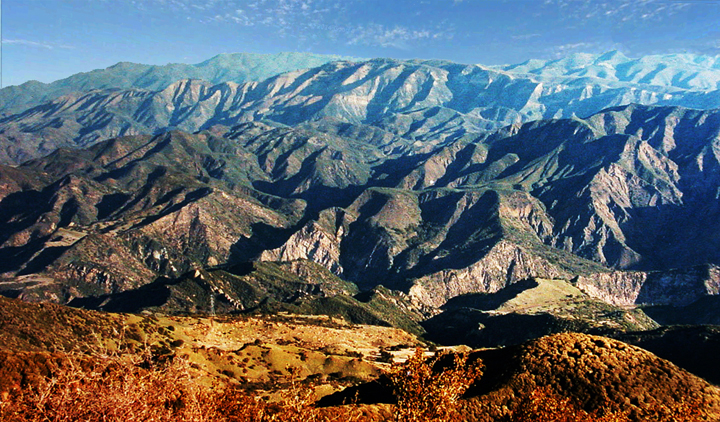
| Click on the image for a larger picture. Some of the great vistas in all of So Cal (AKA, Southern California) can be found in the Santa Ynez Mountains, which form the dramatic backdrop to Santa Barbara immediately north of town. This is a panorama I originally snapped with a Minolta 35mm camera; I then photographed that picture with a Nikon CoolPix 995 digital camera, and eventually edited and processed the digital image through photoshop. Elevation here is about 3,400 feet along the Camino Cielo, along the crest of the Santa Ynez Mountains directly north of Santa Barbara, California. The directional view is a almost due north. |
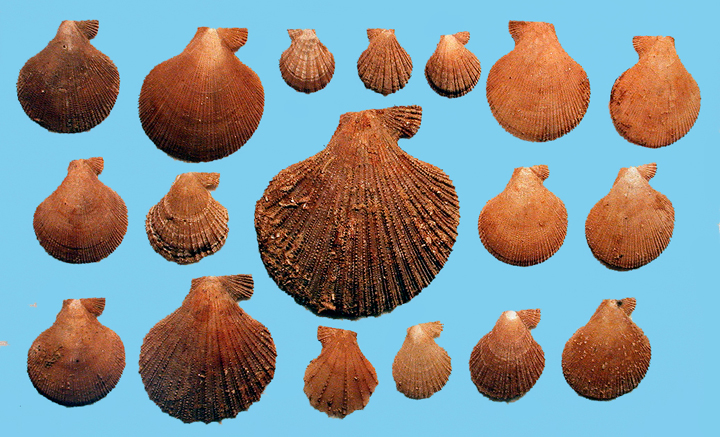
|
Click on the image for a larger picture. A pelecypodal pecten (scallop shell) sampler--all collected from exposures of the middle Pleistocene Santa Barbara Formation, Santa Barbara, California, at Ice Age Fossil Hill and the County Road locality. The Santa Barbara Formation of Santa Barbara County, California, yields one of the largest and best preserved marine Ice Age Pleistocene invertebrate faunas on the US West Coast. It's a really huge fauna, indeed, with innumerable taxa thus far identified: 91 bivalve molluscan forms such as pectens, clams, cockles, oysters, and mussels; 173 gastropods; 6 chitons; 3 scaphopods; brachiopods; bryozoans; corals; pteropods; worm tubes; and around 102 species of foraminifers (minute shells with geometrically intricate internal structures--usually considered microfossils). For scale--the second pecten from left in top row is five centimeters in length--two inches long. Top row, left to right--Chlamys opuntia; Chlamys opuntia; Chlamys jordani; Chlamys hastata; Chlamys jordani; Chlamys opuntia; Chlamys opuntia. Middle row, left to right--Chlamys opuntia; Chlamys jordani; Chlamys islandicus; Chlamys opuntia; Chlamys opuntia. Bottom row, left to right--Chlamys opuntia; Chlamys islandicus; Chlamys hastata; Chlamys hastata; Chlamys jordani; Chlamys opuntia. Photograph originally snapped with a Minolta 35mm camera. |
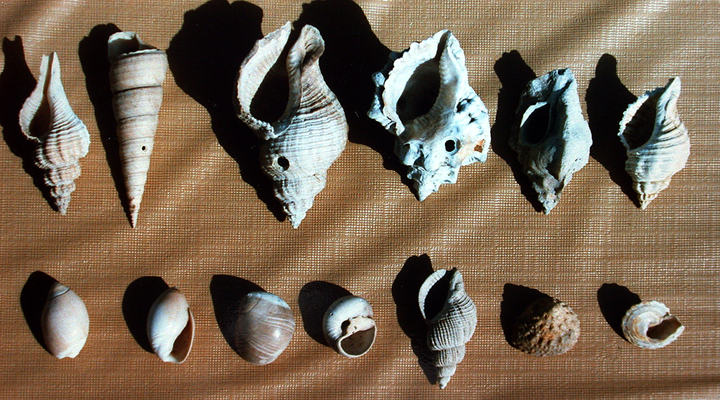
|
Click on the image for a larger picture. A gastropod sampler from the middle Pleistocene Santa Barbara Formation, California. I personally collected all of the specimens from Ice Age Fossil Hill, Santa Barbara County, California. For scale--the olive shell in bottom row, at far left, is 24mm in length--an inch long. Note the cylindrical holes in the specimens in top row; a merciless predatory gastropod, with its specialized radula, is the culprit--penetrating the shell to suck out the meal hidden within. Photograph originally snapped with a Minolta 35mm camera. Top row, left to right--Harfordia robusta; Turritella cooperi; Calicantharus humerosus; Crossata ventricosa; Crossata ventricosa; Calicantharus fortis. Bottom row, left to right--Callianax biplicata; Callianax biplicata; Glossaulax reclusiana; Glossaulax reclusiana; Amphissa versicolor; Lirularias sp.; Architectonica sp. Photograph originally snapped with a Minolta 35mm camera. |
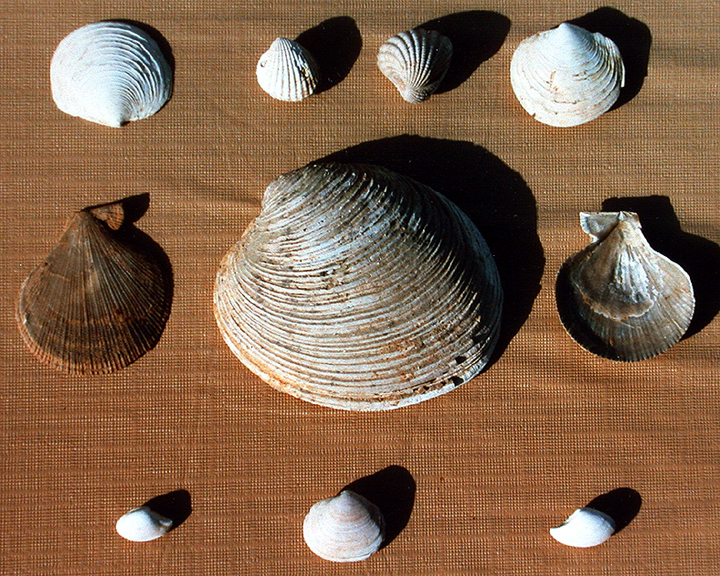
|
Click on the image for a larger picture. A pelecypod sampler from the middle Pleistocene Santa Barbara Formation, California. I personally collected all of the specimens from Ice Age Fossil Hill, Santa Barbara County, California. For scale--the clam shell in top row, at far right, is 28.3mm in length from beak (closest to top edge of photograph) to edge of shell--an inch and one-tenth long. Photograph originally snapped with a Minolta 35mm camera. Top row, left to right: Lucinoma annulatum; Cycloardium ventricosa; Cycloardium ventricosa; Lucinoma annulatum. Middle row--Chlamys opuntia; Humilaria perlaminosa; Chlamys opuntia. Bottom row, left to right--Saccella taphria; Macoma nasuta; Saccella taphria. Photograph originally snapped with a Minolta 35mm camera. |
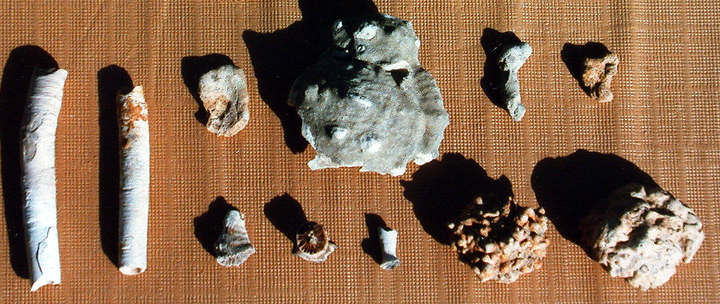
|
Click on the image for a larger picture. A sampler of relatively undescribed (in the scientific literature) fossil material from the middle Pleistocene Santa Barbara Formation, California. I personally collected all of the specimens from Ice Age Fossil Hill, Santa Barbara County, California. For scale--the worm tube at far left is 5.5 cm in length--2.16 inches long. Photograph originally snapped with a Minolta 35mm camera. Left to right: Two worm tubes at far left. Top row, left to right--a bryozoan colony; an encrusting bryozoan colony (on a fragmented pelecypod shell); a bryozoan colony; a bryozoan colony. Bottom row, left to right--three corals, Balanophylliae elegans; and two calcium carbonate clusters, precipitated by algae activity. Photograph originally snapped with a Minolta 35mm camera. |
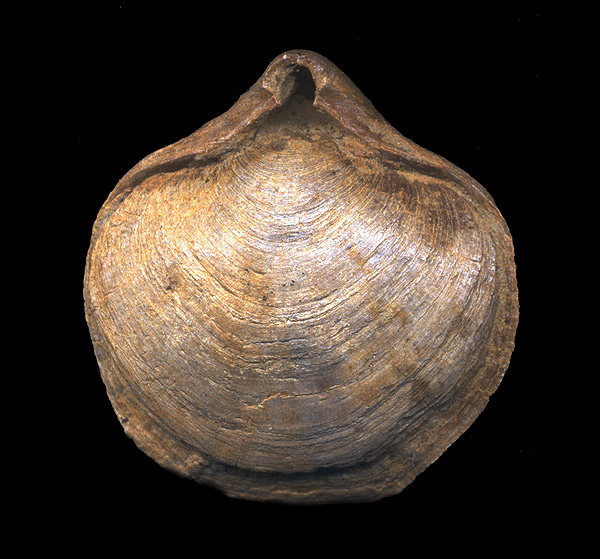
| Click on the image for a larger picture. A brachial valve view of a brachiopod I collected from the middle Pleistocene Santa Barbara Formation at Ice Age Fossil Hill, Santa Barbara County, California. A direct scan of the specimen at 1,200 pixels per inch--probably somewhat of an overkill, admittedly, but the detail on the roughly 1,000,000 year-old brach is practically lifelike; and its original shell material has been preserved intact, unaltered. 45 mm wide (one and three-quarters inch) and 47 mm long (1.85 inches). Scientific name is genus Terebratalia. |
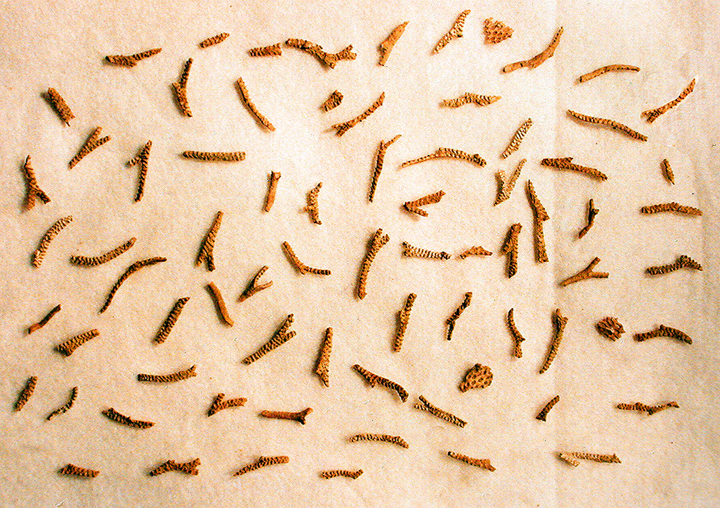
| Click on the image for a larger picture. Undescribed (in the scientific literature) bryozoans I collected from the middle Pleistocene Santa Barbara Formation, Santa Barbara, California. These are pretty diminutive specimens. The largest is no longer than 12 millimeters in length--0.47 of an inch long. Beds of marl in the Santa Barbara Formation often yield prodigious quantities of these twig-like "moss animals"--a colonial organism whose individual animals lived in the minute compartments arranged along the surface of the "twigs." Photograph originally snapped with a Minolta 35mm camera. |

| Click on the image for a larger picture. All from the middle Pleistocene Santa Barbara Formation, California. A few of the more common mollusks one encounters at Ice Age Fossil Hill, Santa Barbara County, California. Collected by members of the Pacific Conchological Club. Photo courtesy Phil Liff-Grieff, who identified the specimens; I edited and processed Phil Liff-Gieff's photograph through photoshop. Left to right--Cycloardium ventricosa (18.3 mm), Olivella biplicata (23.5 mm), Lirobittium quadrifilatum (8.6 mm), Epilucina californica (28 mm), Nassarius mendicus (20 mm). Quick metric scale conversion tip: One mm (millimeter) equals one twenty-fifth of an inch. |
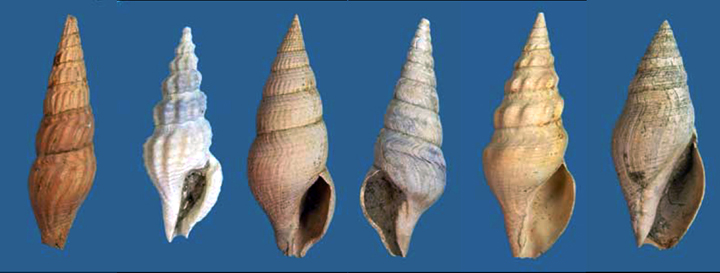
| Click on the image for a larger picture. All from the middle Pleistocene Santa Barbara Formation, Santa Barbara, California. Gastropods one encounters at Ice Age Fossil Hill, Santa Barbara County, California. Collected by members of the Pacific Conchological Club. Photo courtesy Phil Liff-Grieff, who identified the specimens; I edited and processed Phil Liff-Gieff's photograph through photoshop.Left to right--Crassispira semiinflata (44.6 mm), Clathurella canfieldi (13.2 mm), Ophiodermella inermis (33.6 mm), Antiplanes perversa (45 mm), Borsonella sp. (39.7 mm), Megasurcula carpenteriana (40.3 mm). Quick metric scale conversion tip: One mm (millimeter) equals one twenty-fifth of an inch. |
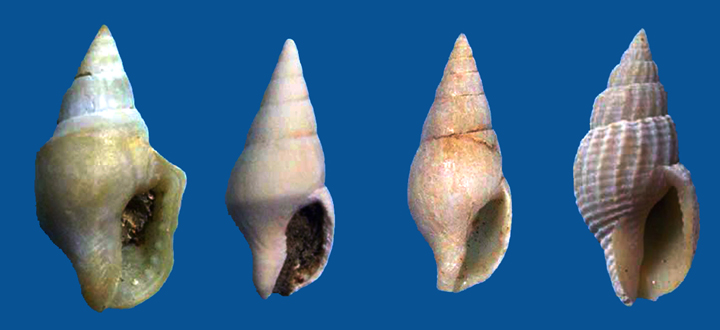
| Click on the image for a larger picture. All from the middle Pleistocene Santa Barbara Formation, Santa Barbara, California. Gastropods one encounters at Ice Age Fossil Hill, Santa Barbara County, California. Collected by members of the Pacific Conchological Club. Photo courtesy Phil Liff-Grieff, who identified the specimens; I edited and processed Phil Liff-Gieff's photograph through photoshop. Left to right--Alia carinata (9.8 mm ), Alia tuberosa (8.3 mm), Astyris gausapata (11.3 mm) and Amphissa versicolor (12.5 mm). Quick metric scale conversion tip: One mm (millimeter) equals one twenty-fifth of an inch. |
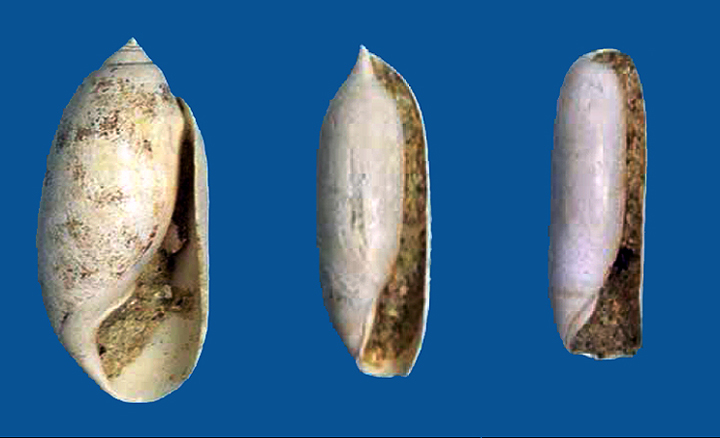
| Click on the image for a larger picture. All from the middle Pleistocene Santa Barbara Formation, Santa Barbara, California. Gastropods one encounters at Ice Age Fossil Hill, Santa Barbara County, California. Collected by members of the Pacific Conchological Club. Photo courtesy Phil Liff-Grieff, who identified the specimens; I edited and processed Phil Liff-Gieff's photograph through photoshop. Left to right--Acteocina culcitella (11.4 mm), Volvullela cylindrica (8 mm), Cylichna cf alba (9.5 mm). Quick metric scale conversion tip: One mm (millimeter) equals one twenty-fifth of an inch. |
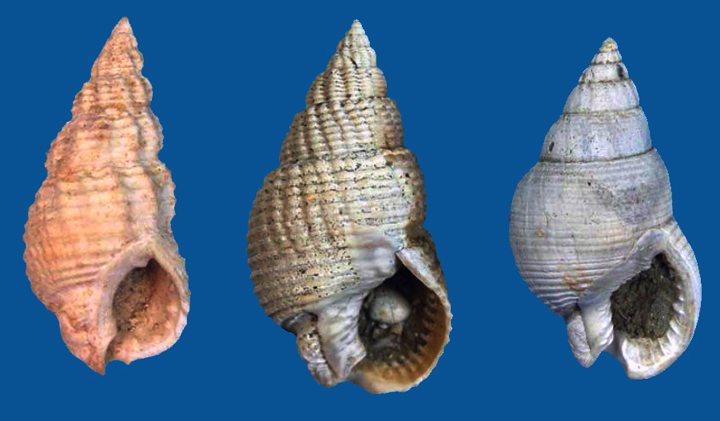
| Click on the image for a larger picture. All from the middle Pleistocene Santa Barbara Formation, Santa Barbara, California. Gastropods one encounters at Ice Age Fossil Hill, Santa Barbara County, California. Collected by members of the Pacific Conchological Club. Photo courtesy Phil Liff-Grieff, who identified the specimens; I edited and processed Phil Liff-Gieff's photograph through photoshop. Left to right--Nassarius mendicus (13.06 mm), Nassarius perpinguis (20.3 mm), and Nassarius insculptus ( 21.48 mm ). Quick metric scale conversion tip: One mm (millimeter) equals one twenty-fifth of an inch. |
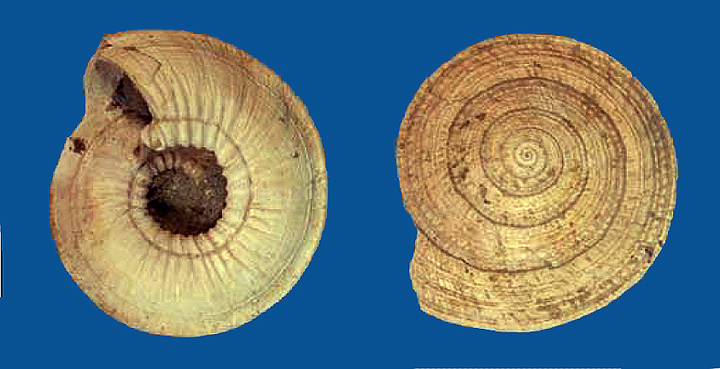
| Click on the image for a larger picture. All from the middle Pleistocene Santa Barbara Formation, Santa Barbara, California. Gastropods one encounters at Ice Age Fossil Hill, Santa Barbara County, California. Collected by members of the Pacific Conchological Club. Photo courtesy Phil Liff-Grieff, who identified the specimens; I edited and processed Phil Liff-Gieff's photograph through photoshop. Both sides of the same Architectonica sp. (24.5 mm). Quick metric scale conversion tip: One mm (millimeter) equals one twenty-fifth of an inch. |
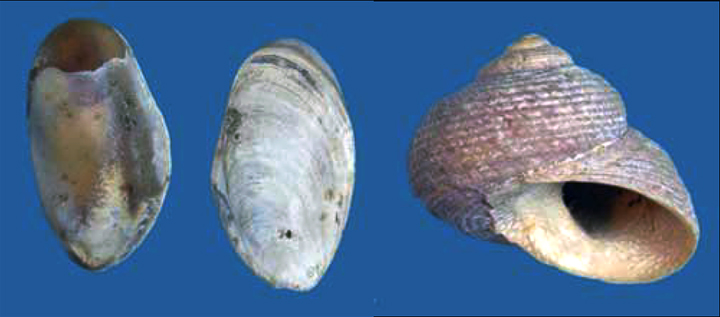
| Click on the image for a larger picture. All from the middle Pleistocene Santa Barbara Formation, Santa Barbara, California. Gastropods one encounters at Ice Age Fossil Hill, Santa Barbara County, California. Collected by members of the Pacific Conchological Club. Photos courtesy Phil Liff-Grieff, who identified the specimens; I edited and processed Phil Liff-Gieff's photograph through photoshop. Left to right--opercula from Astraea gibberosa (27mm), Homalopoma luridum (9.2 mm). Quick metric scale conversion tip: One mm (millimeter) equals one twenty-fifth of an inch. |
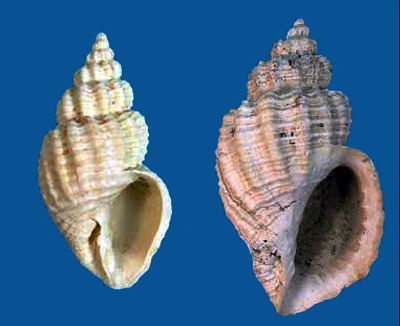 |
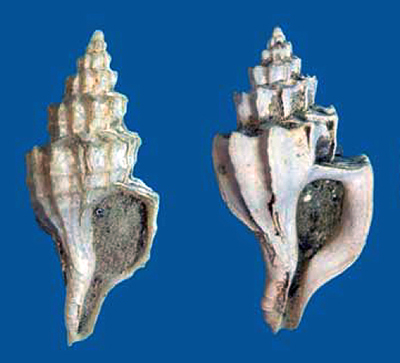 |
| Click on the image for a larger picture. All from the middle Pleistocene Santa Barbara Formation, Santa Barbara, California. Gastropods one encounters at Ice Age Fossil Hill, Santa Barbara County, California. Collected by members of the Pacific Conchological Club. Photos courtesy Phil Liff-Grieff, who identified the specimens; I edited and processed Phil Liff-Gieff's photograph through photoshop. Left to right--Admete gracilor (12.3 mm), Cancellaria arnoldi (24 mm), Boreotrophon orpheus praecursor (14.8 mm), Boreotrophon multicostatus (26 mm). Quick metric scale conversion tip: One mm (millimeter) equals one twenty-fifth of an inch. |
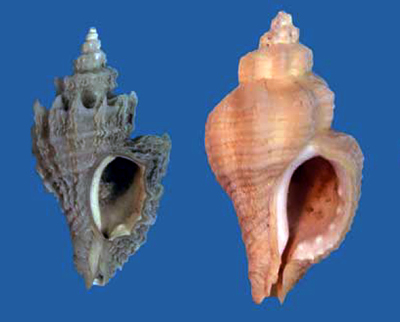 |
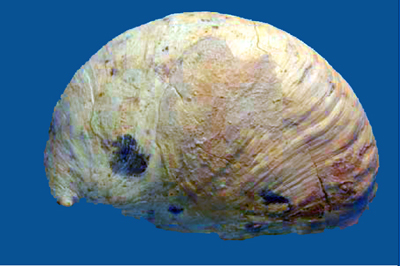 |
| Click on the image for a larger picture. All from the middle Pleistocene Santa Barbara Formation, Santa Barbara, California. Gastropods one encounters at Ice Age Fossil Hill, Santa Barbara County, California. Collected by members of the Pacific Conchological Club. Photos courtesy Phil Liff-Grieff, who identified the specimens; I edited and processed Phil Liff-Gieff's photograph through photoshop. Left to right--Ocinebrina squamulifera (14.5 mm), Ocinebrina. foveolata (18 mm), Crepidula princeps (90 mm). Quick metric scale conversion tip: One mm (millimeter) equals one twenty-fifth of an inch. |
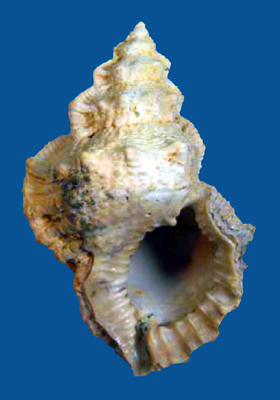 |
 |
| Click on the image for a larger picture. All from the middle Pleistocene Santa Barbara Formation, Santa Barbara, California. Gastropods one encounters at Ice Age Fossil Hill, Santa Barbara County, California. Collected by members of the Pacific Conchological Club. Photos courtesy Phil Liff-Grieff, who identified the specimens; I edited and processed Phil Liff-Gieff's photograph through photoshop. Left to right--Crossata californica (66.7 mm), an undescribed pteropod (8.5 mm). Quick metric scale conversion tip: One mm (millimeter) equals one twenty-fifth of an inch. |
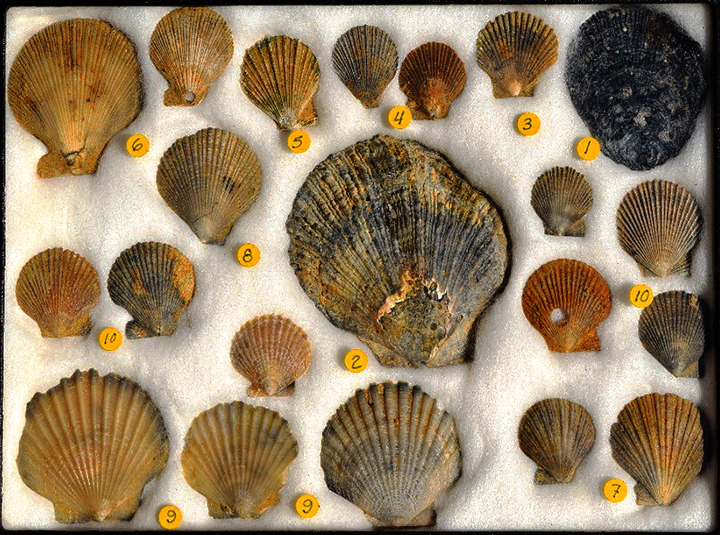
|
Click on the image for a larger picture. Pectens (bivalve pelecypods--also commonly called scallops) from the middle Pleistocene Santa Barbara Formation of Ice Age Fossil Hill, in the vicinity of Santa Barbara, California; for reference size perspective, that largest pecten at center is two and a half inches across at longest axis. They were collected in 1979 by a very successful field collector named Frank Peska Jr., who spent decades finding paleontological remains in the Southern California area. Photograph courtesy a person who goes by the on-line name of "jenny8837." I edited and processed the picture through photoshop. Numbers refer to identifications made by Frank Peska Jr.: 1--Pododesmus machrochisma; 2--Hinnites giganteus; 3--Flabillipecten stearsii; 4--Chlamys hastata hericius; 5--Chlamy hastata hastata; 6--Chlamys opuntia; 7--Chlamys anapleus; 8--Chlamys rubida; 9--Patinopecten caurinus; 10--Chlamys cf C. picoensis. |
| Click on the images for larger pictures. They're in alphabetical order--by genus. Photographs courtesy the Natural History Museum of Los Angeles County; I edited and processed the images through photoshop, and used them here under terms of the following license: Attribution-NonCommercial-NoDerivs 2.0 Generic (CC BY-NC-ND 2.0). |
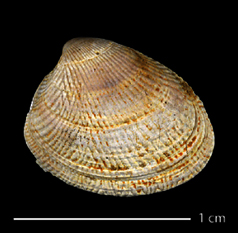 |
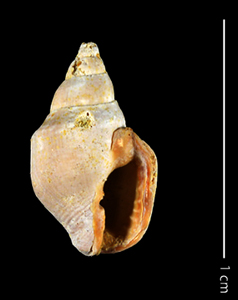 |
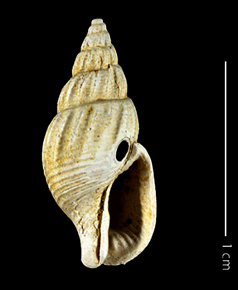 |
|
Click on the images for larger pictures. Note centimeter scale bar. Quick metric scale conversion tip: One cm (centimeter) equals two-fifths inch One mm (millimeter) equals one twenty-fifth of an inch. All from the middle Pleistocene Santa Barbara Formation, Santa Barbara, California. Left to right: A pelecypod, Acilaca strensis (the very first fossil specimen I collected from the Santa Barbara Formation was this very genus-species of pelecypod--from the "Foram Avenue" locality; see On-Site images section, above); a gastropod, Alia carinata; a gastropod, Amphissa versicolor. Photographs courtesy the Natural History Museum of Los Angeles County--from a publicly accessible site; I edited and processed them through photoshop. |
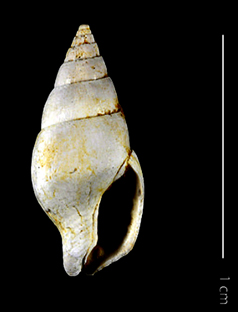 |
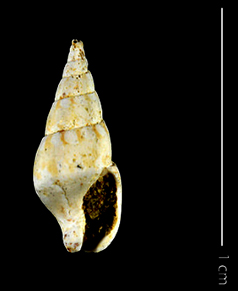 |
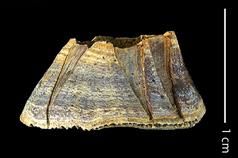 |
|
Click on the images for larger pictures. Note centimeter scale bar. Quick metric scale conversion tip: One cm (centimeter) equals two-fifth inch. One mm (millimeter) equals one twenty-fifth of an inch. All from the middle Pleistocene Santa Barbara Formation, Santa Barbara, California. Left to right: A gastropod, Astyris gausapata; a gastropod, Astyris tuberosa; a barnacle--balanidae. Photographs courtesy the Natural History Museum of Los Angeles County--from a publicly accessible site; I edited and processed them through photoshop. |
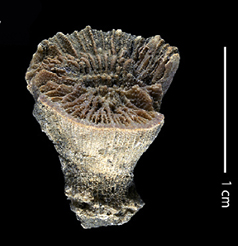 |
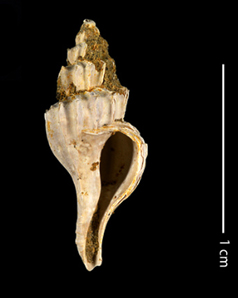 |
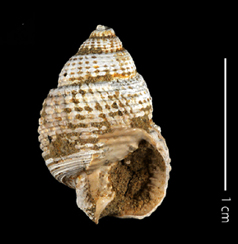 |
|
Click on the images for larger pictures. Note centimeter scale bar. Quick metric scale conversion tip: One cm (centimeter) equals two-fifths inch. One mm (millimeter) equals one twenty-fifth of an inch. All from the middle Pleistocene Santa Barbara Formation, Santa Barbara, California. Left to right: A coral, Balanophylliae elegans; a gastropod, Boreotrophon keepi1a; a gastropod--Caesia perpinguis. Photographs courtesy the Natural History Museum of Los Angeles County--from a publicly accessible site; I edited and processed them through photoshop. |
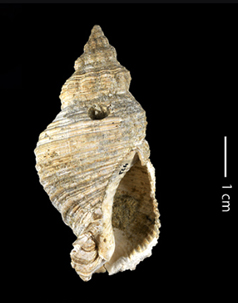 |
 |
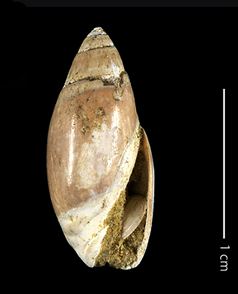 |
|
Click on the images for larger pictures. Note centimeter scale bar. Quick metric scale conversion tip: One cm (centimeter) equals two-fifths inch. One mm (millimeter) equals one twenty-fifth of an inch. All from the middle Pleistocene Santa Barbara Formation, Santa Barbara, California. Left to right--all gastropods: Calicantharus fortis; Calicantharus humerosus; Callianax baetica. Photographs courtesy the Natural History Museum of Los Angeles County--from a publicly accessible site; I edited and processed them through photoshop. |
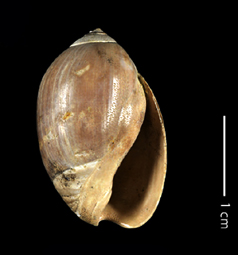 |
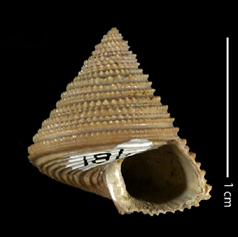 |
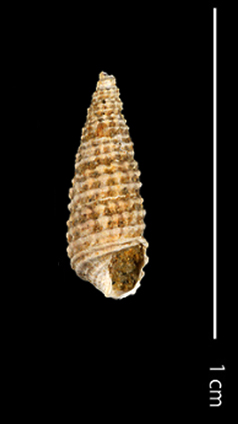 |
|
Click on the images for larger pictures. Note centimeter scale bar. Quick metric scale conversion tip: One cm (centimeter) equals two-fifths inch. One mm (millimeter) equals one twenty-fifth of an inch. All from the middle Pleistocene Santa Barbara Formation, Santa Barbara, California. Left to right--all gastropods: Callianax biplicata; Calliostoma annulatum; Cerithiopsidella sp. Photographs courtesy the Natural History Museum of Los Angeles County--from a publicly accessible site; I edited and processed them through photoshop. |
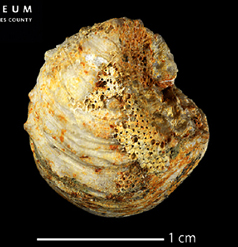 |
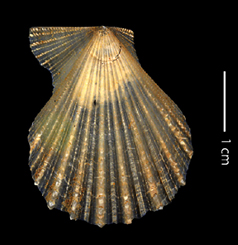 |
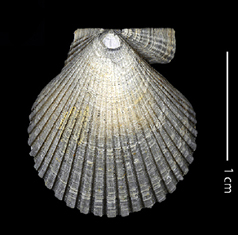 |
|
Click on the images for larger pictures. Note centimeter scale bar. Quick metric scale conversion tip: One cm (centimeter) equals two-fifths inch. One mm (millimeter) equals one twenty-fifth of an inch. All from the middle Pleistocene Santa Barbara Formation, Santa Barbara, California. Left to right--all pelecypods: Chama granti; Chlamys hastata; Chlamys jordani. Photographs courtesy the Natural History Museum of Los Angeles County--from a publicly accessible site; I edited and processed them through photoshop. |
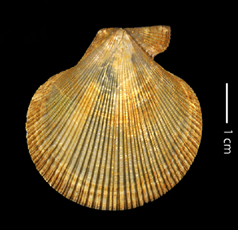 |
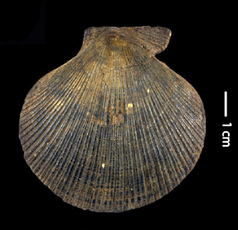 |
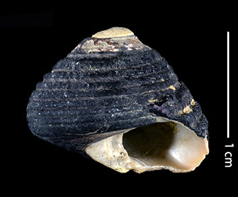 |
|
Click on the images for larger pictures. Note centimeter scale bar. Quick metric scale conversion tip: One cm (centimeter) equals two-fifths inch. One mm (millimeter) equals one twenty-fifth of an inch. All from the middle Pleistocene Santa Barbara Formation, Santa Barbara, California. Left to right: a pecten--Chlamys opuntia; a pecten--Chlamys picoensis; a gastropod--Chlorostoma gallina. Photographs courtesy the Natural History Museum of Los Angeles County--from a publicly accessible site; I edited and processed them through photoshop. |
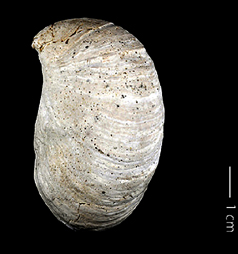 |
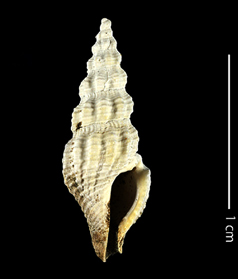 |
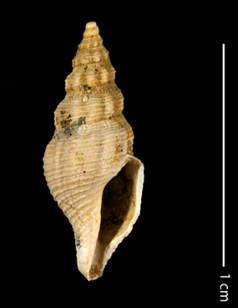 |
|
Click on the images for larger pictures. Note centimeter scale bar. Quick metric scale conversion tip: One cm (centimeter) equals two-fifths inch. One mm (millimeter) equals one twenty-fifth of an inch. All from the middle Pleistocene Santa Barbara Formation, Santa Barbara, California. Left to right--all gastropods: Crepidula princeps; Crockerella conradiana; Crockerella cymodoce. Photographs courtesy the Natural History Museum of Los Angeles County--from a publicly accessible site; I edited and processed them through photoshop. |
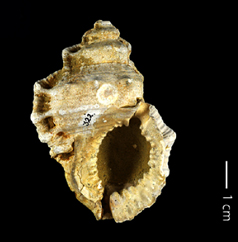 |
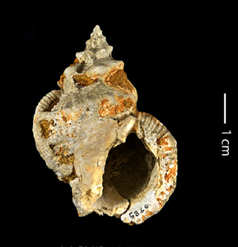 |
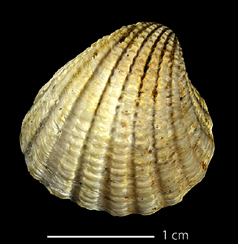 |
|
Click on the images for larger pictures. Note centimeter scale bar. Quick metric scale conversion tip: One cm (centimeter) equals two-fifths inch. One mm (millimeter) equals one twenty-fifth of an inch. All from the middle Pleistocene Santa Barbara Formation, Santa Barbara, California. Left to right: a gastropod--Crossata californica; a gastropod--Crossata ventricosa; a pelecypod--Cyclocardia californica. Photographs courtesy the Natural History Museum of Los Angeles County--from a publicly accessible site; I edited and processed them through photoshop. |
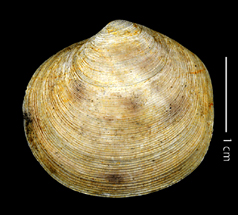 |
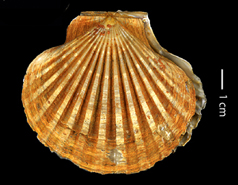 |
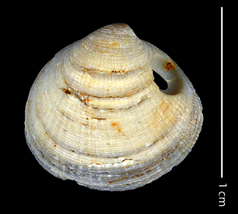 |
|
Click on the images for larger pictures. Note centimeter scale bar. Quick metric scale conversion tip: One cm (centimeter) equals two-fifths inch. One mm (millimeter) equals one twenty-fifth of an inch. All from the middle Pleistocene Santa Barbara Formation, Santa Barbara, California. Left to right--all pelecypods: Epilucina californica; a pecten--Euvola bella; Glycymeris septentrionalis. Photographs courtesy the Natural History Museum of Los Angeles County--from a publicly accessible site; I edited and processed them through photoshop. |
 |
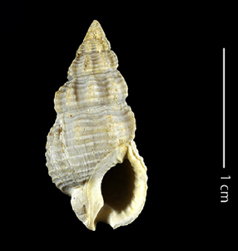 |
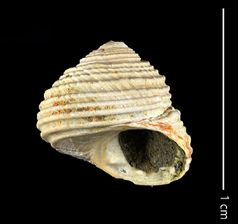 |
|
Click on the images for larger pictures. Note centimeter scale bar. Quick metric scale conversion tip: One cm (centimeter) equals two-fifths inch. One mm (millimeter) equals one twenty-fifth of an inch. All from the middle Pleistocene Santa Barbara Formation, Santa Barbara, California. Left to right--all gastropods: Harfordia robusta; Hima cooperi; Homalopoma berryi. Photographs courtesy the Natural History Museum of Los Angeles County--from a publicly accessible site; I edited and processed them through photoshop. |
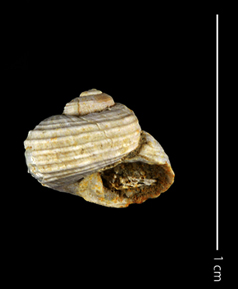 |
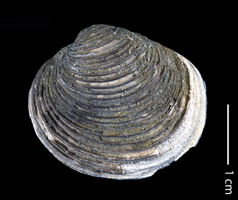 |
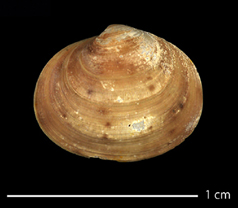 |
|
Click on the images for larger pictures. Note centimeter scale bar. Quick metric scale conversion tip: One cm (centimeter) equals two-fifths inch. One mm (millimeter) equals one twenty-fifth of an inch. All from the middle Pleistocene Santa Barbara Formation, Santa Barbara, California. Left to right: a gastropod--Homalopoma luridum; a pelecypod--Humilaria perlaminosa; a pelecypod--Kellia suborbicularis. Photographs courtesy the Natural History Museum of Los Angeles County--from a publicly accessible site; I edited and processed them through photoshop. |
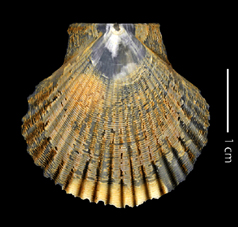 |
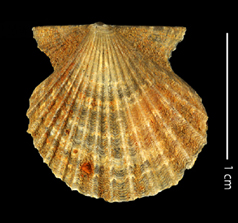 |
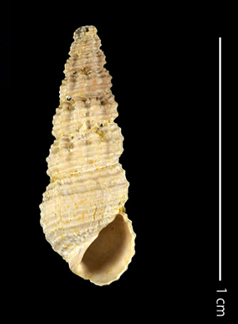 |
|
Click on the images for larger pictures. Note centimeter scale bar. Quick metric scale conversion tip: One cm (centimeter) equals two-fifths inch. One mm (millimeter) equals one twenty-fifth of an inch. All from the middle Pleistocene Santa Barbara Formation, Santa Barbara, California. Left to right: a pecten-Leopecten stearnsii; a pecten--Leptopecten latiauratus; a gastropod--Lirobittium rugatum. Photographs courtesy the Natural History Museum of Los Angeles County--from a publicly accessible site; I edited and processed them through photoshop. |
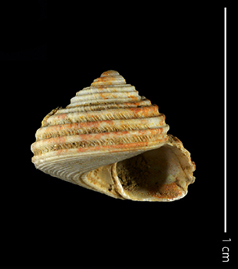 |
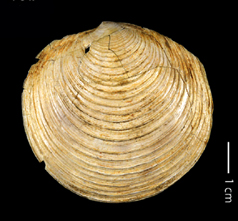 |
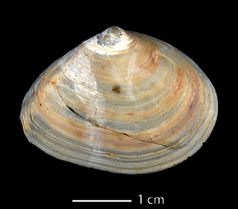 |
|
Click on the images for larger pictures. Note centimeter scale bar. Quick metric scale conversion tip: One cm (centimeter) equals two-fifths inch. One mm (millimeter) equals one twenty-fifth of an inch. All from the middle Pleistocene Santa Barbara Formation, Santa Barbara, California. Left to right: a gastropod--Lirularia sp; a pelecypod--Lucinoma annulatum; a pelecypod--Macoma nasuta. Photographs courtesy the Natural History Museum of Los Angeles County--from a publicly accessible site; I edited and processed them through photoshop. |
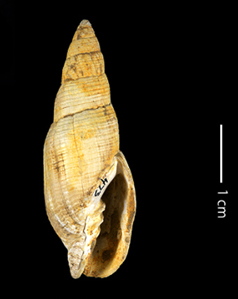 |
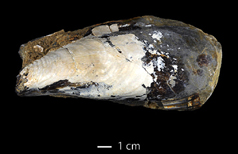 |
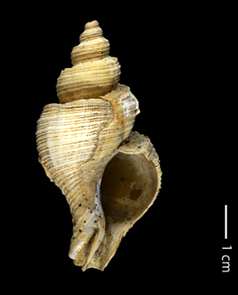 |
|
Click on the images for larger pictures. Note centimeter scale bar. Quick metric scale conversion tip: One cm (centimeter) equals two-fifths inch. One mm (millimeter) equals one twenty-fifth of an inch. All from the middle Pleistocene Santa Barbara Formation, Santa Barbara, California. Left to right: a gastropod--Mitra idae; a pelecypod mussel--Mytilus californianus; a gastropopd--Neptunea tabulata. Photographs courtesy the Natural History Museum of Los Angeles County--from a publicly accessible site; I edited and processed them through photoshop. |
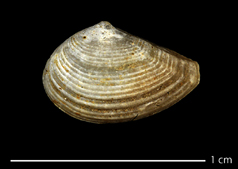 |
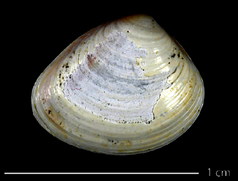 |
 |
|
Click on the images for larger pictures. Note centimeter scale bar. Quick metric scale conversion tip: One cm (centimeter) equals two-fifths inch. One mm (millimeter) equals one twenty-fifth of an inch. All from the middle Pleistocene Santa Barbara Formation, Santa Barbara, California. Left to right--all pelecypods: Nuculana minuta; Nutricola tantilla; a pecten--Patinopecten caurinus. Photographs courtesy the Natural History Museum of Los Angeles County--from a publicly accessible site; I edited and processed them through photoshop. |
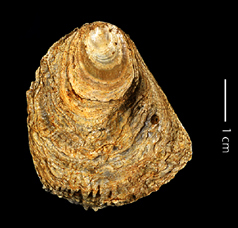 |
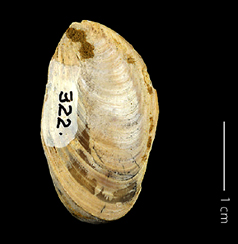 |
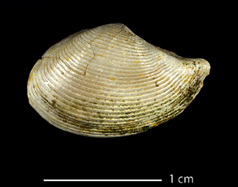 |
|
Click on the images for larger pictures. Note centimeter scale bar. Quick metric scale conversion tip: One cm (centimeter) equals two-fifths inch. One mm (millimeter) equals one twenty-fifth of an inch. All from the middle Pleistocene Santa Barbara Formation, Santa Barbara, California. Left to right: a pelecypod--Pododesmus macrochisma; an operculum from a gastropod--Pomaulax gibberosa; a pelecypod--Saccella taphria. Photographs courtesy the Natural History Museum of Los Angeles County--from a publicly accessible site; I edited and processed them through photoshop. |
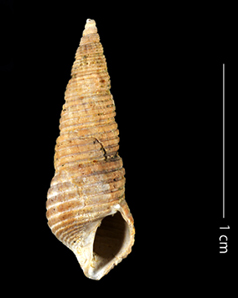 |
 |
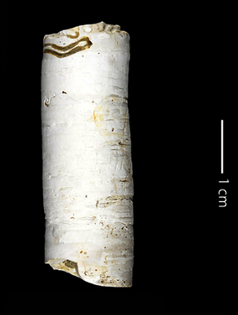 |
|
Click on the images for larger pictures. Note centimeter scale bar. Quick metric scale conversion tip: One cm (centimeter) equals two-fifths inch. One mm (millimeter) equals one twenty-fifth of an inch. All from the middle Pleistocene Santa Barbara Formation, Santa Barbara, California. Left to right: a gastropod--Stylidium eschrichtii1a; a gastropod--Turritella cooperi; a worm tube. Photographs courtesy the Natural History Museum of Los Angeles County--from a publicly accessible site; I edited and processed them through photoshop. |
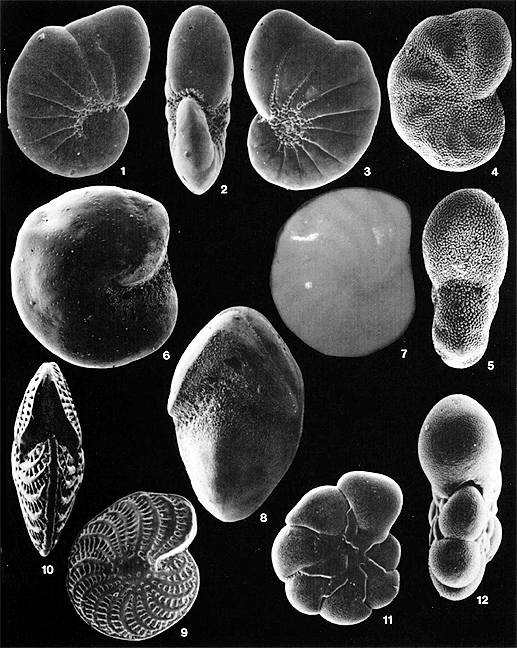
| Click on the image for a larger picture. Foraminifers from exposures of the middle Pleistocene Santa Barbara Formation along "Foram Avenue"--a colloquial name given to a residential street in Santa Barbara, California, that produces great quantities of excellently preserved microfossils. The specimens are roughly 750,000 years old. Photograph and caption, below, courtesy a specific technical publication. |

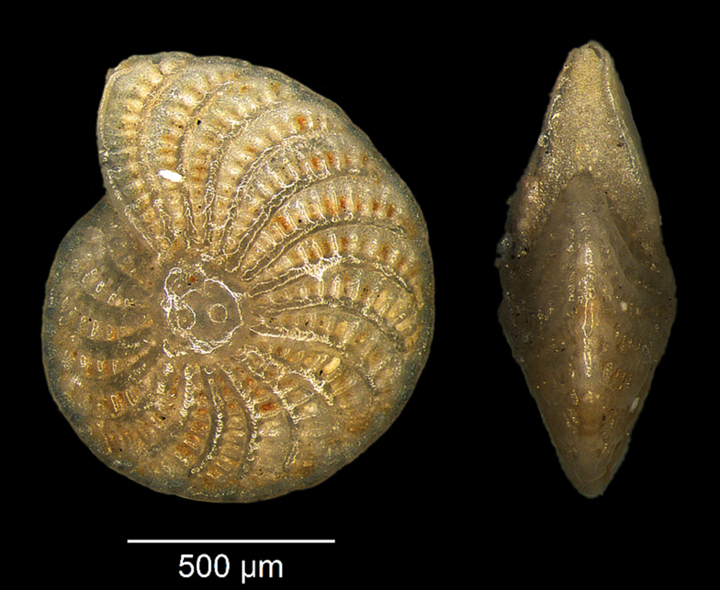
| Click on the image for a larger picture. Two views of the same species of foraminifer, called scientifically Elphidium barbarensis. Scale bar is 500 microns long, which is 0.02 inch. From the middle Pleistocene Santa Barbara Formation, exposed in the vicinity of Santa Barbara, California. Image courtesy the California Academy of Sciences, used per parameters prescribed by the Creative Commons license. I edited and processed the picture through photoshop. |
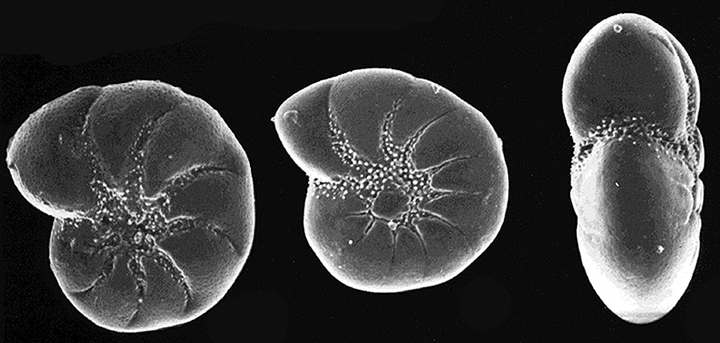
| Click on the image for a larger picture. Three views of the same species of foraminfer, called scientifically Cibroelphidium tumidum. Specimens magnified approximately 500 times. All from an upper Pleistocene marine terrace (about 47,000 years old) exposed in the vicinity of Santa Barbara, California. An image courtesy a technical document that I edited and processed through photoshop. |
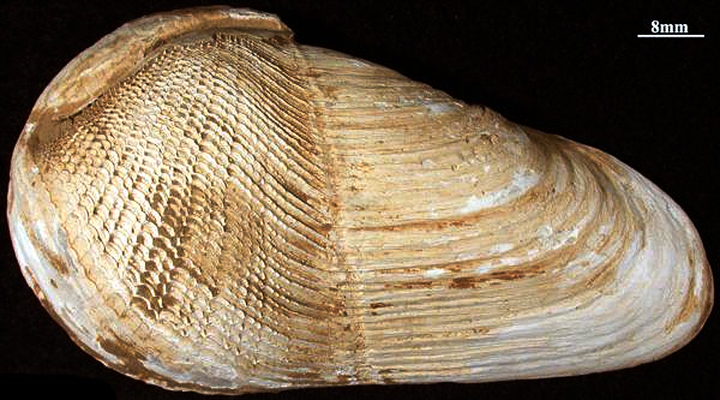
| Click on the image for a larger picture. Note millimeter scale bar at upper right. A bivalve peleycypod from an unnamed upper Pleistocene marine terrace deposit (approximately 47,000 years old), Santa Barbara, California. This is a member of the Family Pholadidae--the so-called piddock clams, which bore into shale, clay, firm mud, and rocks. Scientific name is Penitella turnerae. Photograph courtesty the Natural History Museum of Los Angeles County, under terms of the following license: Attribution-NonCommercial-ShareAlike 2.0 Generic (CC BY-NC-SA 2.0). I edited and processed the image through photoshop. |

| Click on the image for a larger picture. Bivalve pelecypodal mollusks from an unnamed upper Pleistocene marine terrace deposit (approximately 47,000 years old), Santa Barbara, California. Technical scientitic name is Clinocardium nuttalli. Photograph courtesy an individual who goes by the cyber-name of MikeR. I edited and processed the image through photoshop. |
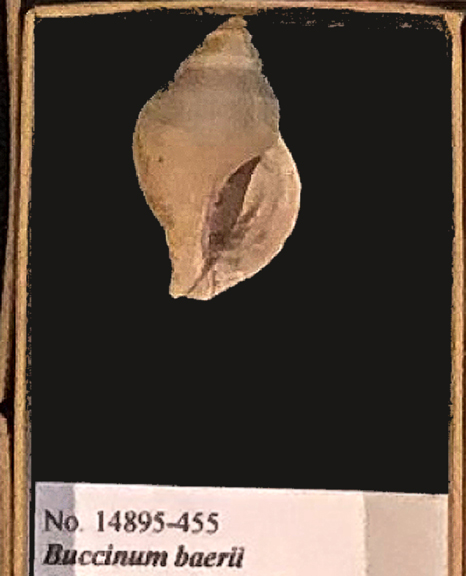
| Click on the image for a larger picture. A gastropod mollusk from an unnamed upper Pleistocene marine terrace deposit (approximately 47,000 years old), Santa Barbara, California. Technical scientitic name is Buccinum baerii. Photograph courtesy an individual who goes by the cyber-name of MikeR. I edited and processed the image through photoshop. |
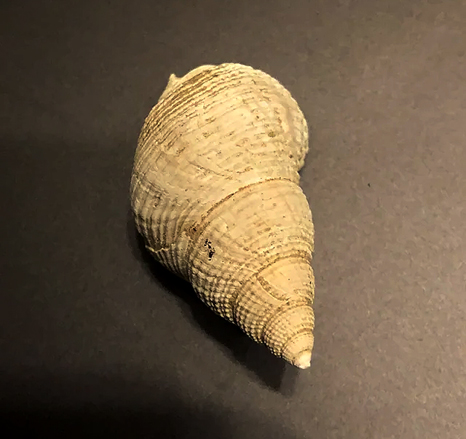
| Click on the image for a larger picture. A gastropod mollusk from an unnamed upper Pleistocene marine terrace deposit (approximately 47,000 years old), Santa Barbara, California. Photograph courtesy an individual who goes by the cyber-name of reshcsinha. I edited and processed the image through photoshop. |
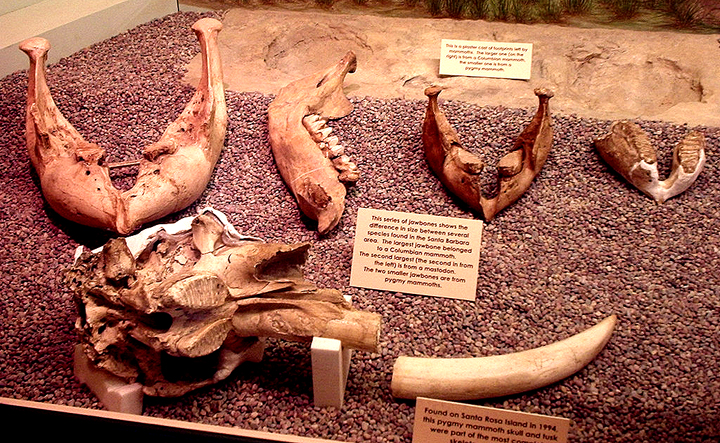
| Click on the image for a larger picture. Some of Santa Barbara's famous Pleistocene proboscidean material, on display at the Santa Barbara Museum of Natural History. Tusk and skull at bottom are from a dwarf mammoth, collected in 1994 from Santa Rosa Island, Channel Islands National Park, off the coast of Santa Barbara, California. Top row, left to right: Jawbone from a Columbian mammoth; jaw from a mastodon; the last two are from a dwarf mammoth--all from the Santa Barbara, California, area. Photograph courtesy coolslandsong24--a picture taken on August 12, 2003. I edited and processed the image through photoshop. |

| Click on the image for a larger picture. A complete femur (AKA, the thigh bone), perhaps from a shore bird (it's about four and a half inches long), from the late Pleistocene Carpenteria Tar Pits of Santa Barbara County, California. Photograph courtesy coolslandsong24--a picture taken on August 22, 2012, at the Santa Barbara Museum of Natural History. I edited and processed the image through photoshop. |

| Click on the image for a larger picture. Oysters I collected from exposures of the middle Eocene Coldwater Sandstone (dated by magnetostratigraphy at 42.5 to 39.5 million years old) in the Santa Ynez Mountains, above (that is, north of) Santa Barbara, California. All the oysters can be referred to Ostrea idriaensis, which forms persistent--and sometimes spectacular--reefs in the Coldwater Sandstone of Santa Barbara County's Santa Ynez Mountains. Bottom row shows interior views of the pelecypodal oyster valves. Photograph originally snapped with a Minolta 35mm camera. |
 |
 |
| Click on the images for larger pictures. Carbonized pelecypod clams I collected from exposures of the middle Eocene Coldwater Sandstone (dated by magnetostratigraphy at 42.5 to 39.5 million years old) at the so-called "Coldwater Clam Quarry" in the foothills of the Santa Ynez Mountains, above (that is, north of) Santa Barbara, California. It's a locality rich with several species of Eocene mollusks--bivalve pelecypods and gastropods; occasional shark teeth occur there, too. Both specimens belong to the genus Callista. Photograph originally snapped with a Minolta 35mm camera. |
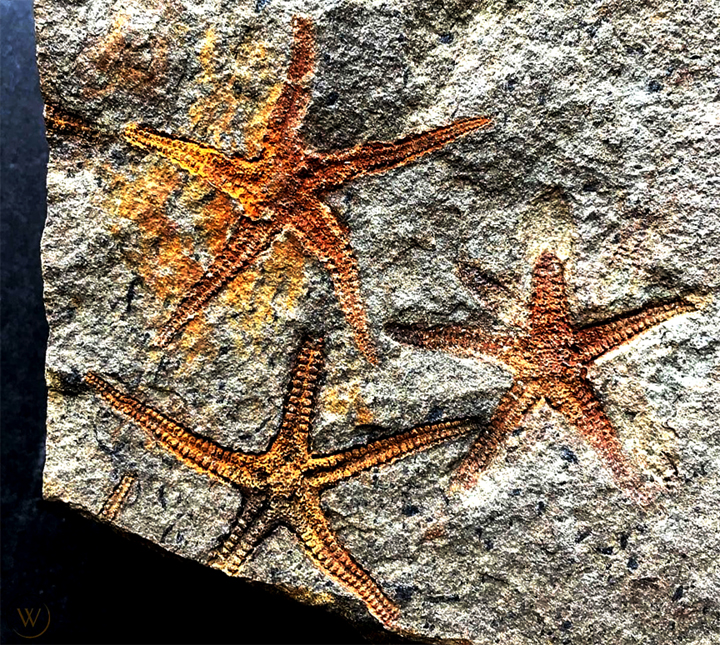
| Click on the image for a larger picture. Three brittlestars preserved on a slab of middle Eocene Cozy Dell Shale, from a world-famous locality situated in the Ojai area of neighboring Ventura County, California--just west of Santa Barbara County. Usually assigned scientifically to the genus-species Henricia venturana. Photograph courtesy an anonymous individual. |
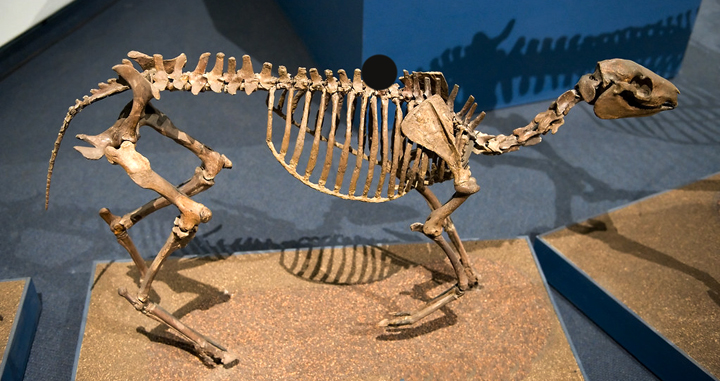
| Click on the image for a larger picture. A complete skeleton of an extinct three-toed browsing horse called Miohippus, collected by vertebrate paleontology technicians from late Oligocene exposures (approximately 28 million years old) of the middle Eocene (around 42 million years) to lower Miocene (about 20 million years ago) Sespe Formation at world famous Kew Quarry, Las Posas Hills, Ventura County (which is contiguous with Santa Barbara County). Photograph courtesy an individual who goes by the cybername coolislandsong. I edited and processed the image through photoshop. |
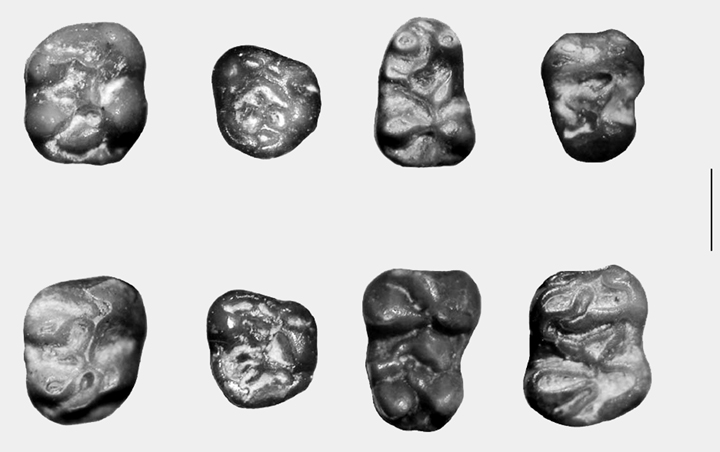
| Click on the image for a larger picture. A selection of teeth from an extinct cricetid rodent called Simimys landeri, collected by vertebrate paleontology technicians from late middle Eocene exposures (approximately 38 million years old) of the middle Eocene (around 42 million years) to lower Miocene (about 20 million years ago) Sespe Formation--one of the most famous vertebrate fossil-bearing rock units in all of southern California--Las Posas Hills, Ventura County (which is contiguous with Santa Barbara County). Extant cricetid rodents include: true hamsters; voles; lemmings; and New World rats and mice. For scale, bar at far right is one millimeter long (0.093 inch). Photograph courtesy Thomas S. Kelly. |
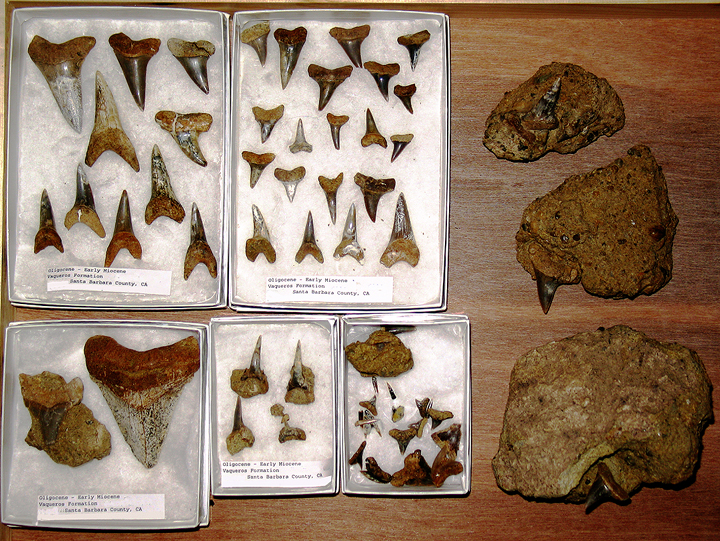
| Click on the image for larger pictures. Shark teeth from the middle to upper Oligocene to Lower Miocene Vaqueros Formation of Santa Barbara County, California. These specimens came from the deep back country of Santa Barbara County, well inland from the coastal environs of the community of Santa Barbara. Photograph courtesy an individual who goes by the cybername of "isurus90064". |
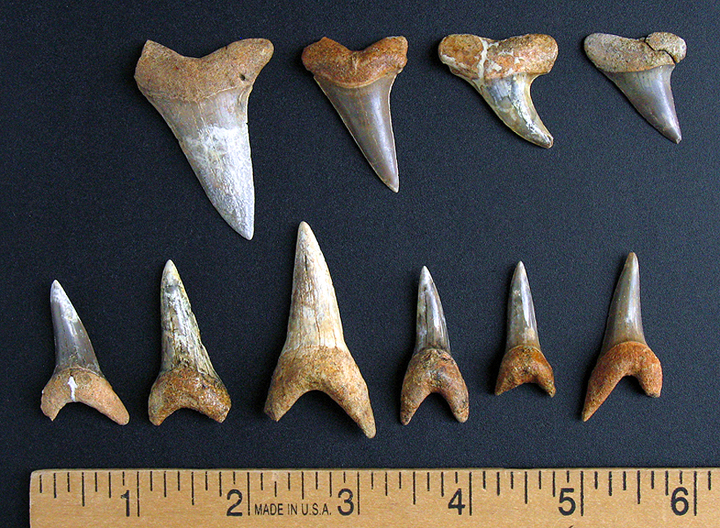
| Click on the image for a larger picture. A closer look at the Isurus sp. shark teeth in the box at upper left in the image, above. All from the middle to upper Oligocene to Lower Miocene Vaqueros Formation of Santa Barbara County, California. These specimens came from the deep back country of Santa Barbara County, well inland from the coastal environs of the community of Santa Barbara. Photograph courtesy an individual who goes by the cybername of "isurus90064". |
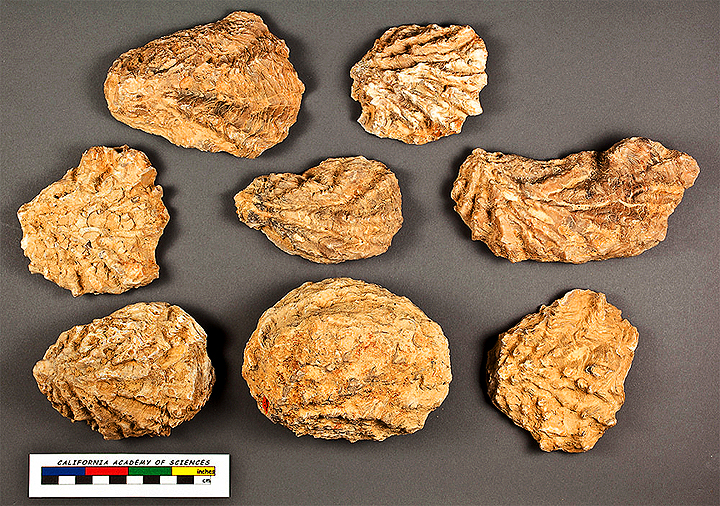
| Click on the image for a larger picture. Oysters from the upper Oligocene to Lower Miocene Vaqueros Formation of Santa Barbara County, California. Note the inches and centimeter scale bar at lower left. These specimens came from the deep back country of Santa Barbara County, well inland from the coastal environs of the community of Santa Barbara. Called scientifically, Ostrea wiedeyi. Photograph courtesy the California Academy of Sciences under terms of the following license: Attribution-NonCommercial-NoDerivs 2.0 Generic (CC BY-NC-ND 2.0). |
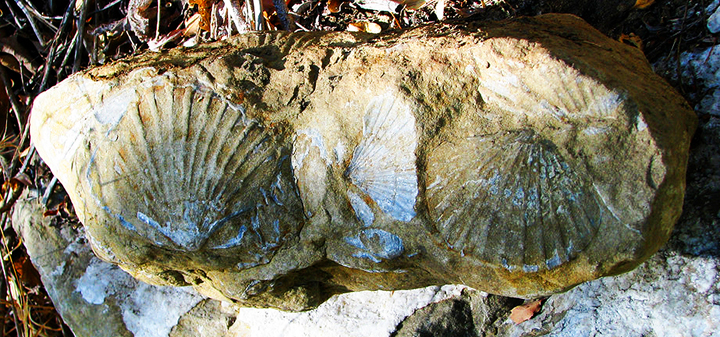
| Click on the image for a larger picture. Pectens (also called scallop shells) from the southernmost outcrops of the middle Miocene Temblor Formation (around 16 to 15 million years old), Santa Ynez Moutains, north of Santa Barbara, Santa Barbara County, California. This is the same geologic rock unit that produces the world-famous Sharktooth Hill Bone Bed in the western foothills of the Sierra Nevada, northeast of Bakersfied, California. Photograph courtesy James Wapotich--a picture snapped on December 27, 2009. I edited and processed the image through photoshop. |
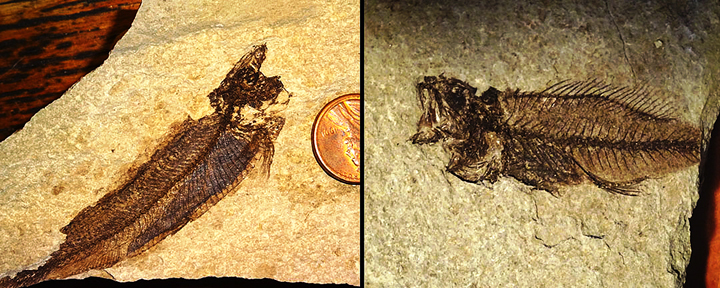
| Click on the image for a larger picture. Fossil fish from the middle to upper Miocene Monterey Formation (roughly 15 to 8 million years old), exposed along the Pacific Coast in the vicinity of Santa Barbara, California. The Monterey yields an astounding variety of fossil remains: a plethora of microfossils (foraminifers, diatoms, and radiolaria); seaweeds; whales; sea lions; walruses, bony and cartilaginous fishes; and birds. Photograph courtesy The Nautiloid Network. I edited and processed the image through photoshop. |
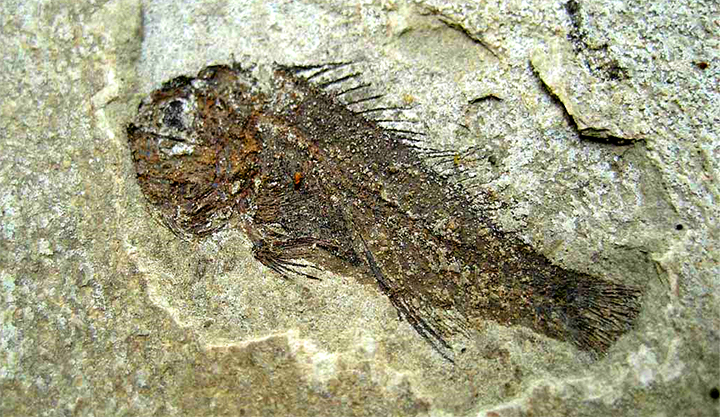
| Click on the image for a larger picture. A fossil fish from the middle to upper Miocene Monterey Formation (roughly 15 to 8 million years old), exposed along along the Pacific Coast in the vicinity of Santa Barbara, California. The Monterey yields an astounding variety of fossil remains: a plethora of microfossils (foraminifers, diatoms, and radiolaria); seaweeds; whales; sea lions; walruses, bony and cartilaginous fishes; and birds. Photograph courtesy Rockhound Times. I edited and processed the image through photoshop. |
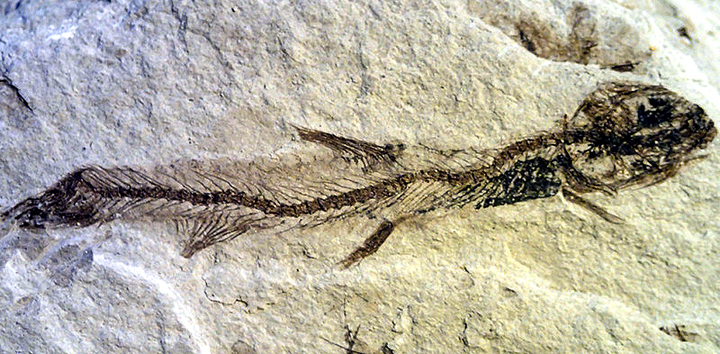
| Click on the image for a larger picture. A fossil fish from the middle to upper Miocene Monterey Formation (roughly 15 to 8 million years old), exposed along along the Pacific Coast in the vicinity of Santa Barbara, California. The Monterey yields an astounding variety of fossil remains: a plethora of microfossils (foraminifers, diatoms, and radiolaria); seaweeds; whales; sea lions; walruses, bony and cartilaginous fishes; and birds. Photograph courtesy an individual who goes by the cybername of HardlyatWork. I edited and processed the image through photoshop. |
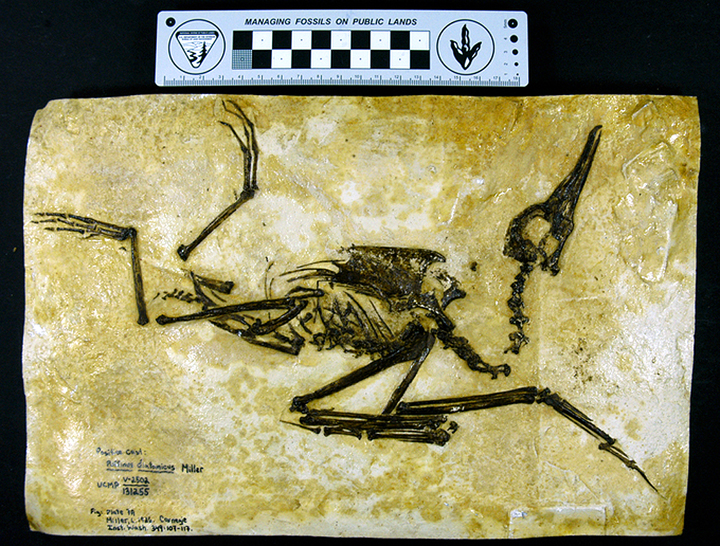
| Click on the image for a larger picture. A virtually complete skeleton of a shearwater seabird from the middle to upper Miocene Monterey Formation (roughly 15 to 8 million years old), exposed in Santa Barbara County, California. Called scientically, Puffinus diatomicus. The Monterey yields an astounding variety of fossil remains: a plethora of microfossils (foraminifers, diatoms, and radiolaria); seaweeds; whales; sea lions; walruses, bony and cartilaginous fishes; and birds. Photograph by Eric Holt, courtesy Copyright © 2016 University of California Museum of Paleontology; image used per parameters provided by the Creative Commons license. I edited and processed the photo through photoshop. |
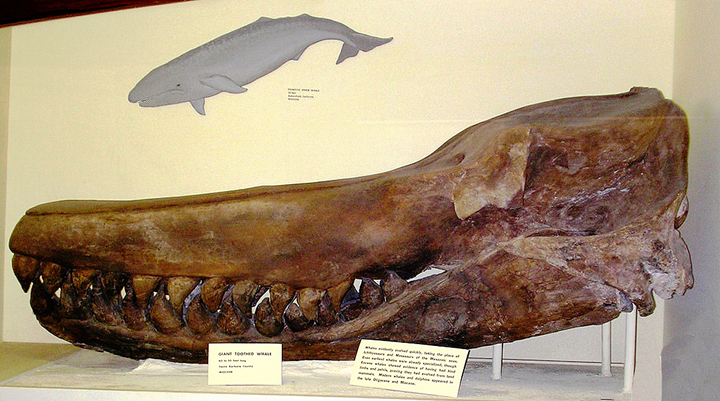
| Click on the image for a larger picture. The skull of a giant toothed sperm whale from the middle to upper Miocene Monterey Formation (roughly 15 to 8 million years old), collected in 1952 from the vicinity of Santa Barbara, California--now on display at the Santa Barbara Museum of Natural History. The Monterey yields an astounding variety of fossil remains: a plethora of microfossils (foraminifers, diatoms, and radiolaria); seaweeds; whales; sea lions; walruses, bony and cartilaginous fishes; and birds. Photograph courtesy coolislandsong24--a picture snapped on March 15, 2008. I edited an processed the image through photoshop. |
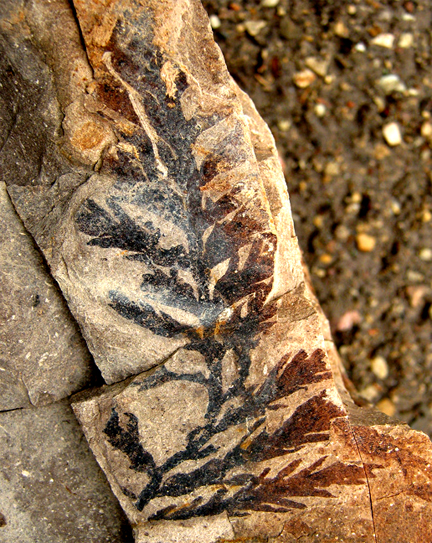
| Click on the image a for larger picture. Seaweed from the middle to upper Miocene Monterey Formation (roughly 15 to 8 million years old), exposed along along the Pacific Coast in the vicinity of Santa Barbara, California. Specimen is 71.6mm long. The Monterey yields an astounding variety of fossil remains: a plethora of microfossils (foraminifers, diatoms, and radiolaria); seaweeds; whales; sea lions; walruses, bony and cartilaginous fishes; and birds. Photograph courtesy Jeff Goddard, who snapped it on April 11, 2012. I edited and processed the image through photoshop. |
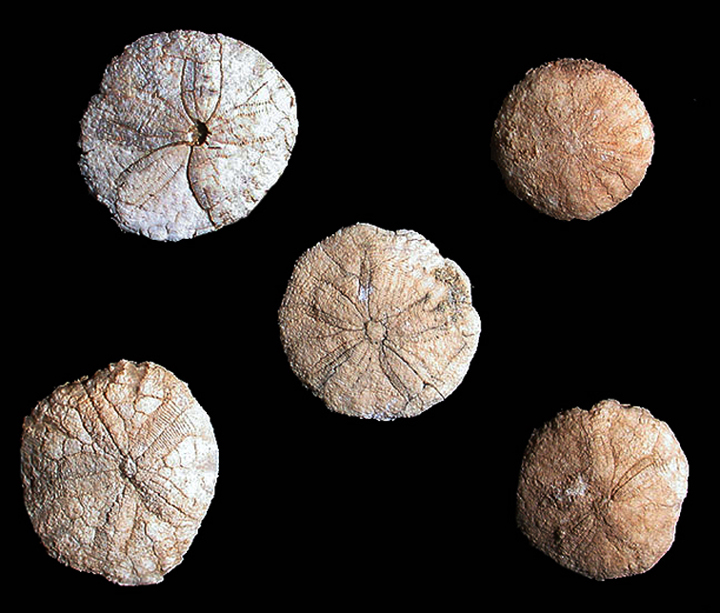
| Click on the image for a larger picture. Sand dollars from the middle Miocene Branch Canyon Formation of Santa Barbara County, California. These specimens came from the deep back country of Santa Barbara County, well inland from the coastal environs of the community of Santa Barbara. |
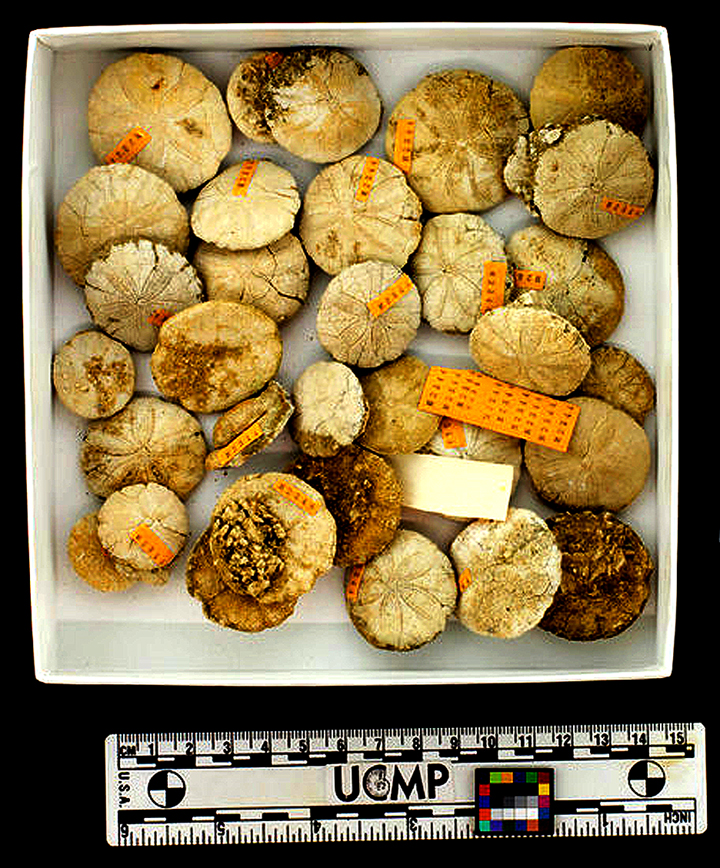
| Click on the image for a larger picture. Sand dollars from the middle Miocene Branch Canyon Formation of Santa Barbara County, California. These specimens came from the deep back country of Santa Barbara County, well inland from the coastal environs of the community of Santa Barbara. A photograph taken by an unspecified member of the University California Museum of Paleontology, courtesy Copyright © 2015 University of California Museum of Paleontology; image used per parameters provided by the Creative Commons license. From a collection made in 1962. I edited and processed the photo through photoshop. |

| Click on the image for a larger picture. A complete whale vertebra from the upper Miocene to lower Pliocene Sisquoc Formation (around 6 to 4 million years old), exposed along the Pacific Coast in the vicinity of Santa Barbara, California; it's an especially rich paleontological unit, preserving the remains of diatoms, radiolarians, arenaceous foraminifers, sponges, and occasional marine mammal bones. Photograph courtesy Kim Noves, who collected the specimen. I edited and processed the image through photoshop. |
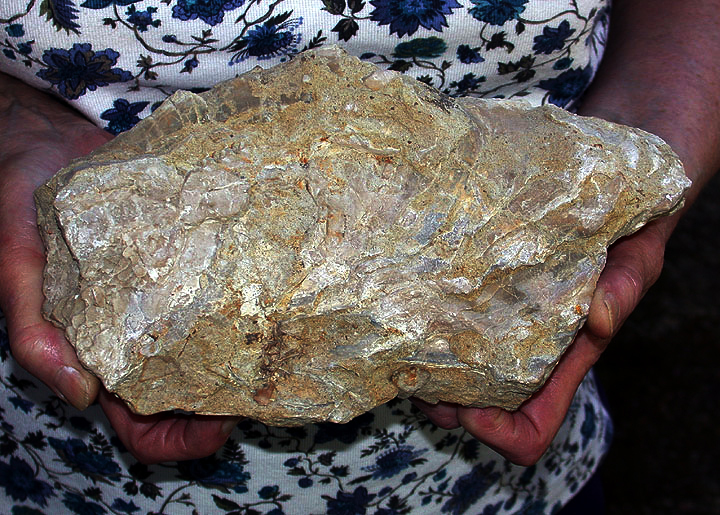
| Click on the image for a larger picture. A giant oyster from the upper Miocene to lower Pliocene Santa Margarita Formation of Santa Barbara County, California. The specimen came from the deep back country of Santa Barbara County, far inland from the coastal environs of the community of Santa Barbara. |
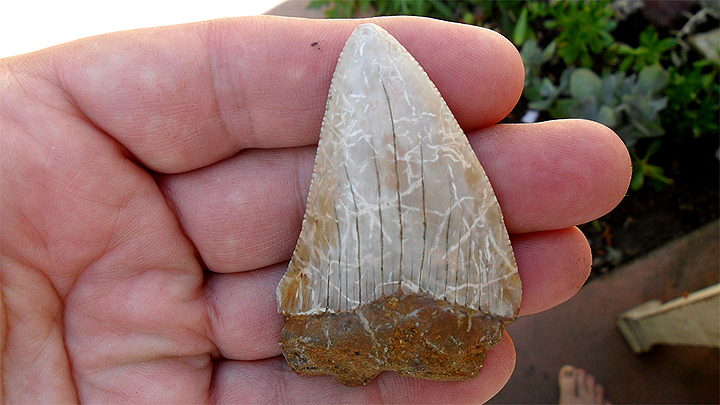
| Click on the image for a larger picture. A great white shark tooth from the upper Miocene to lower Pliocene Santa Margarita Formation of Santa Barbara County, California. Photograph courtesy an individual who goes by the cyber-name "caldigger." I edited and processed the image through photoshop. |
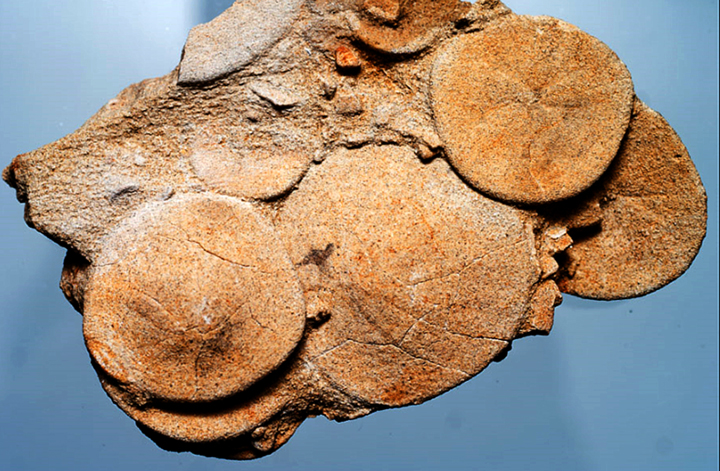
| Click on the image for a larger picture. Sand dollars of the genus Dendraster variety, from the upper Pliocene Careaga Formation of Santa Barbara County, California. Photograph courtesy an individual who goes by the cyber-name "AncientEarth." I edited and processed the image through photoshop. |

|